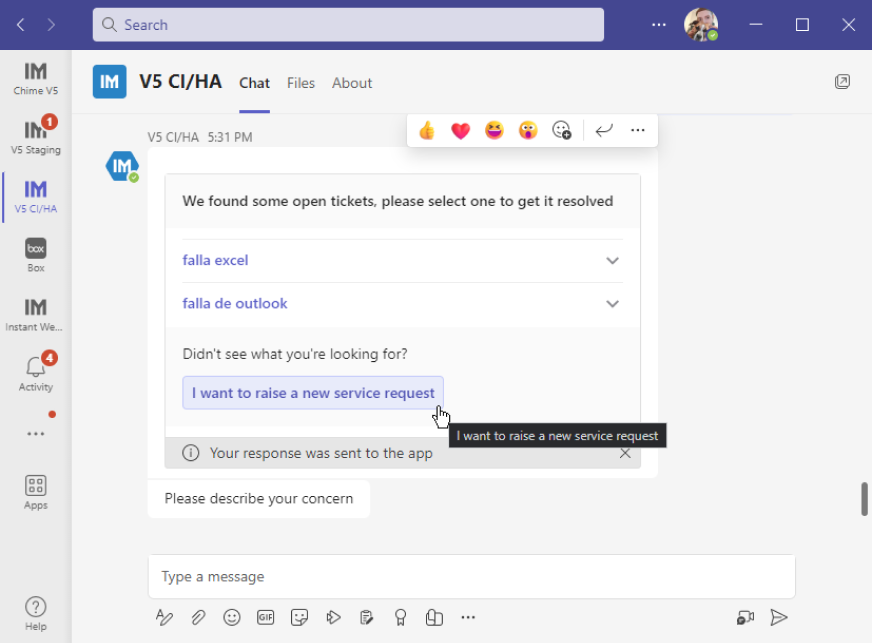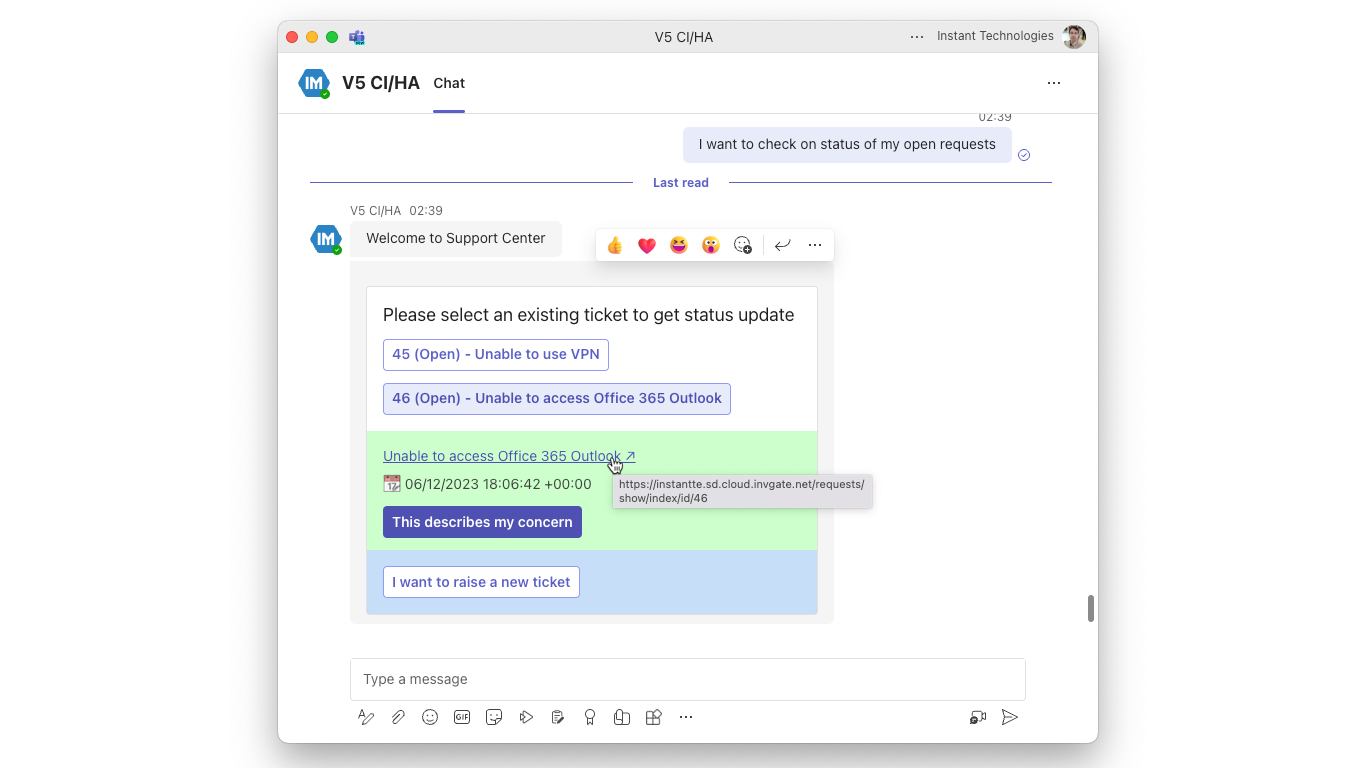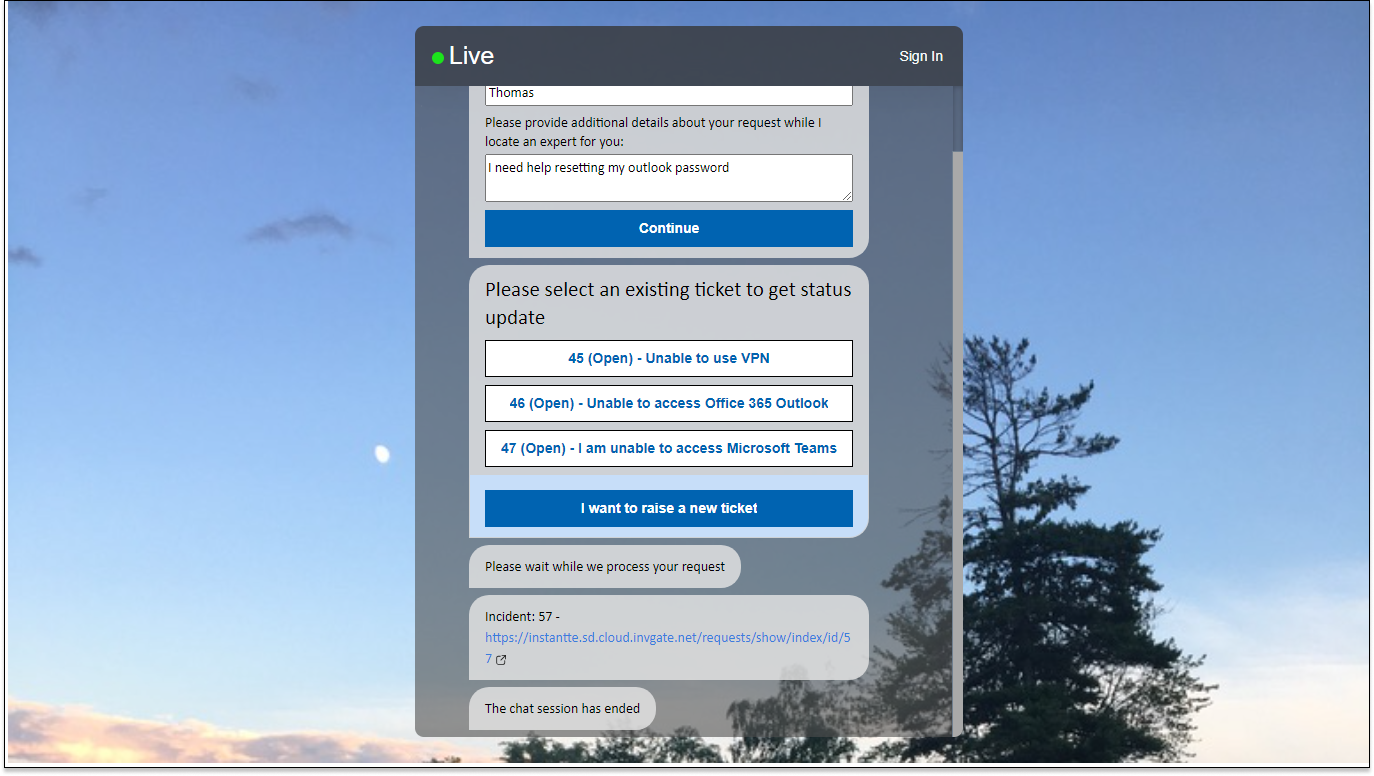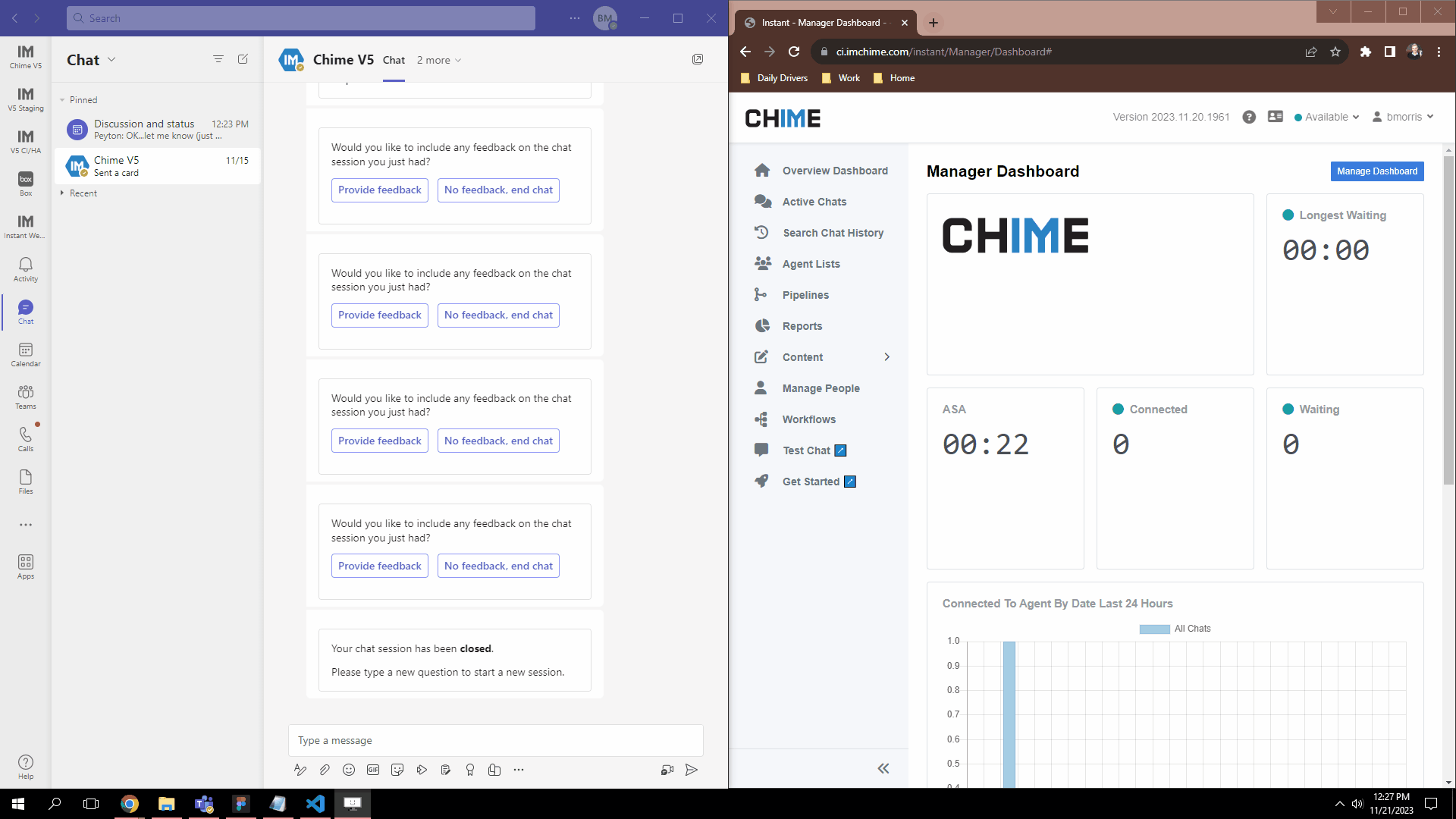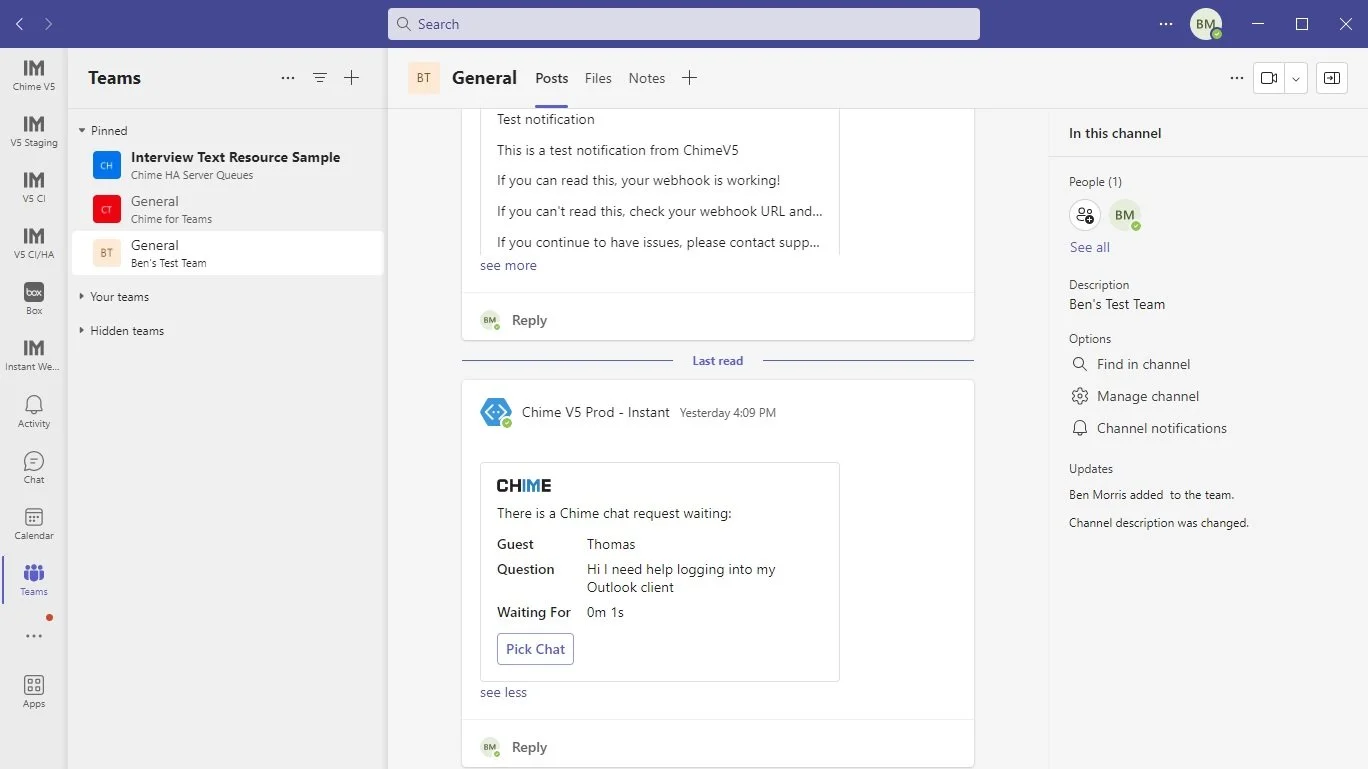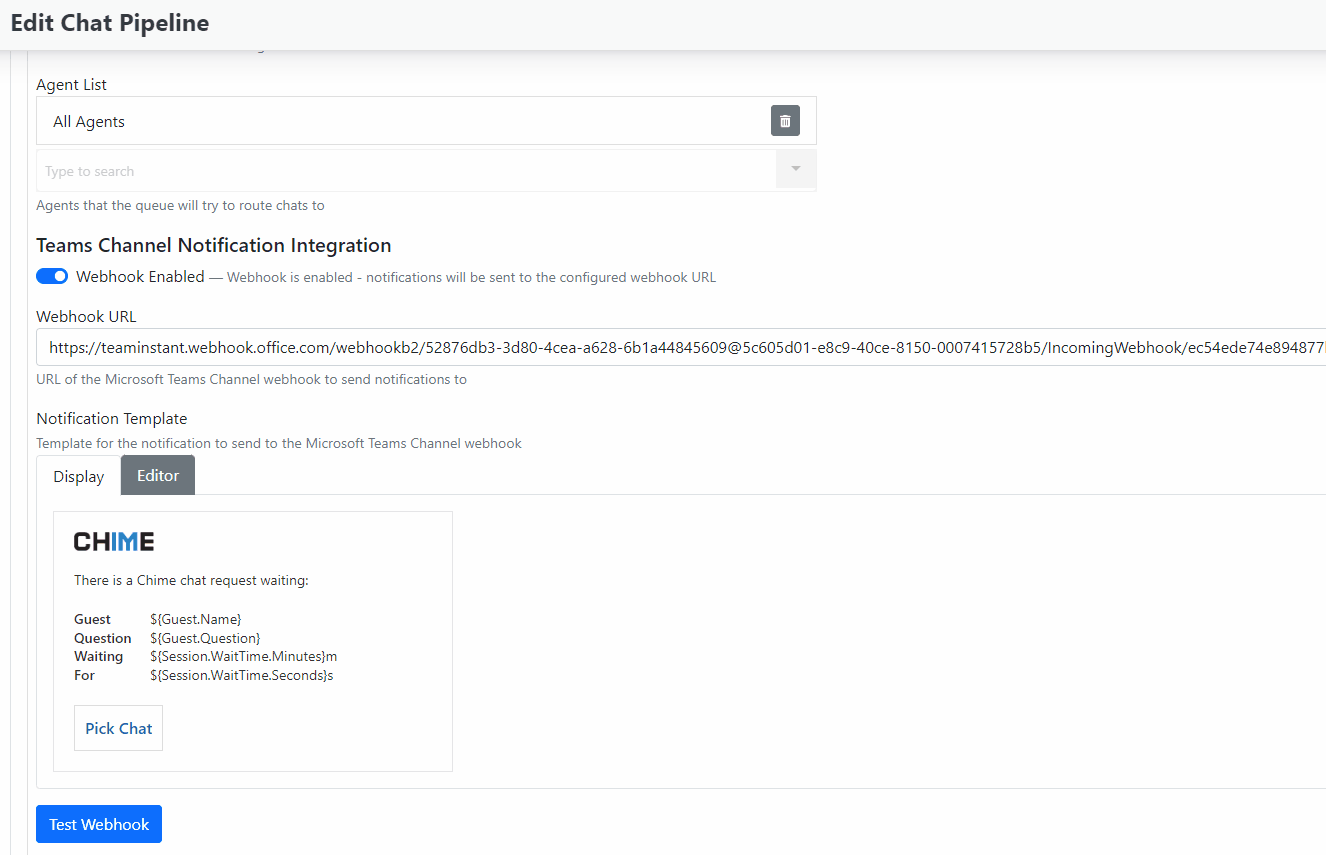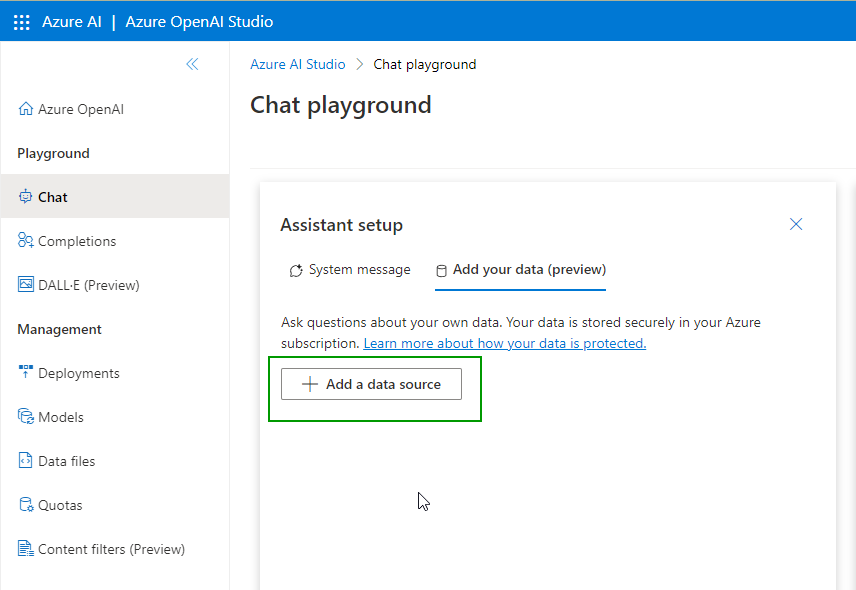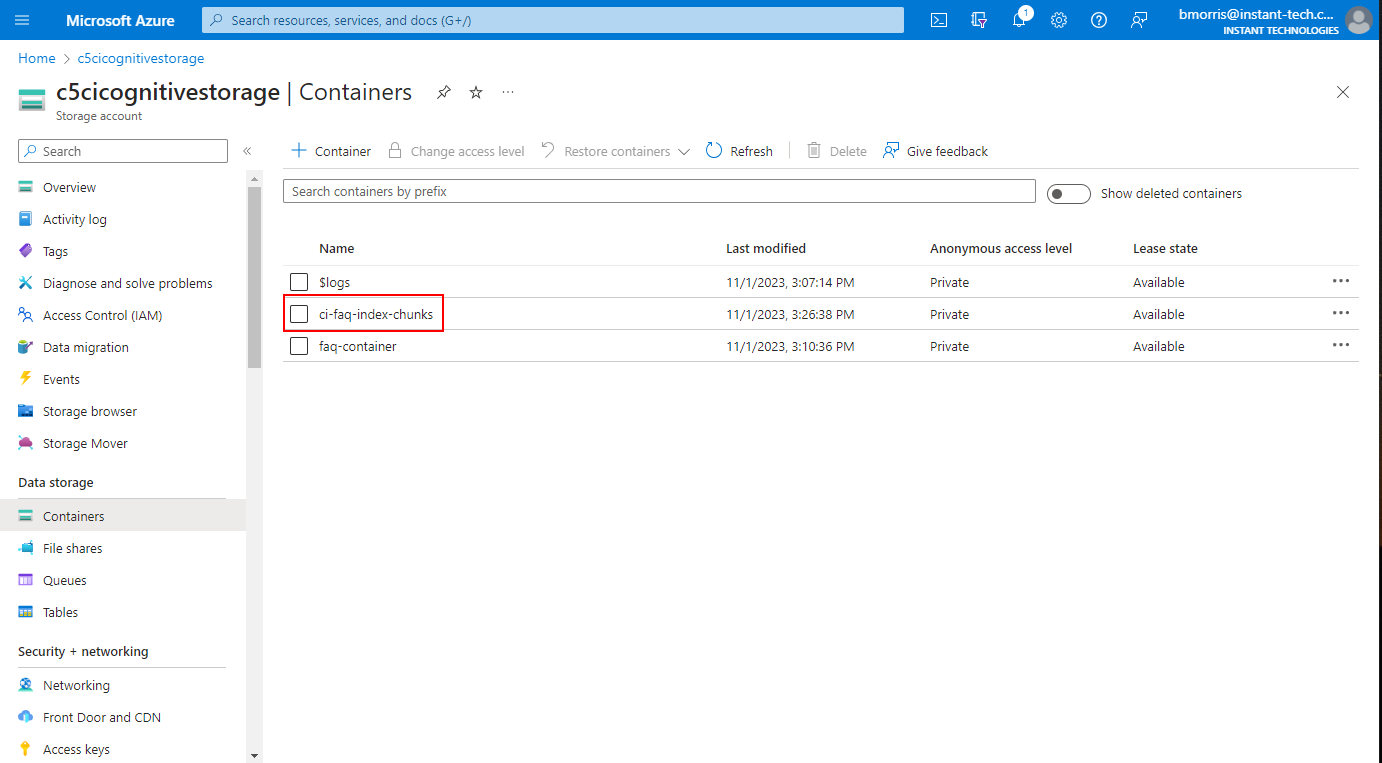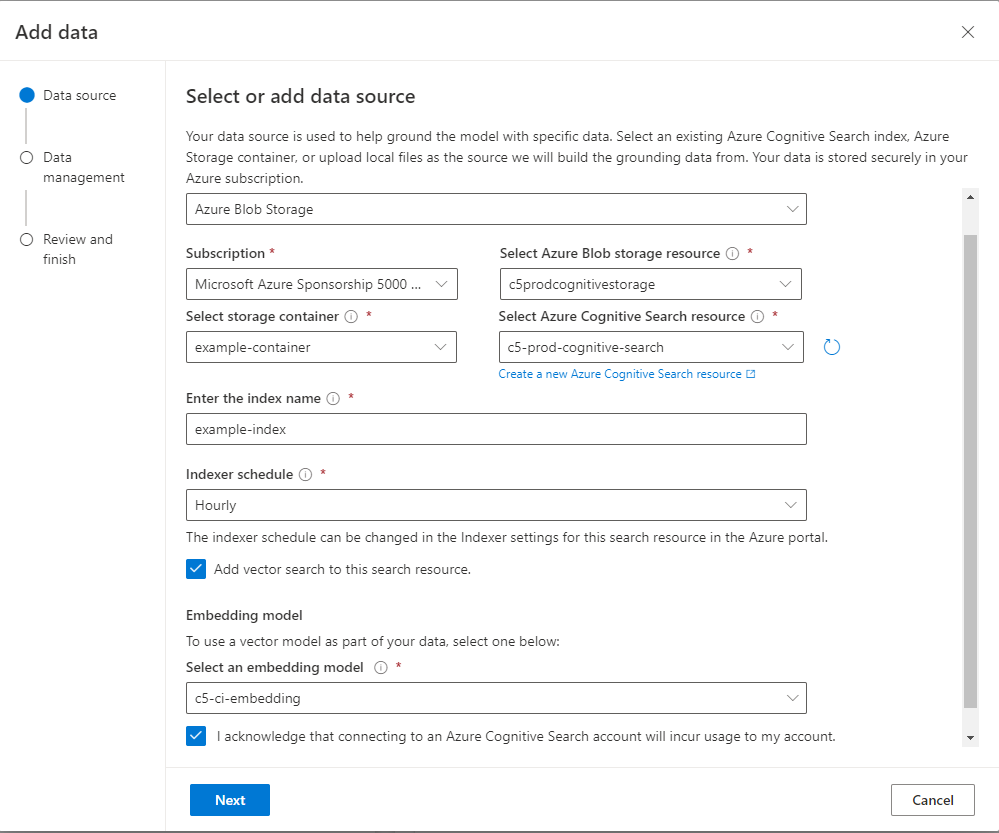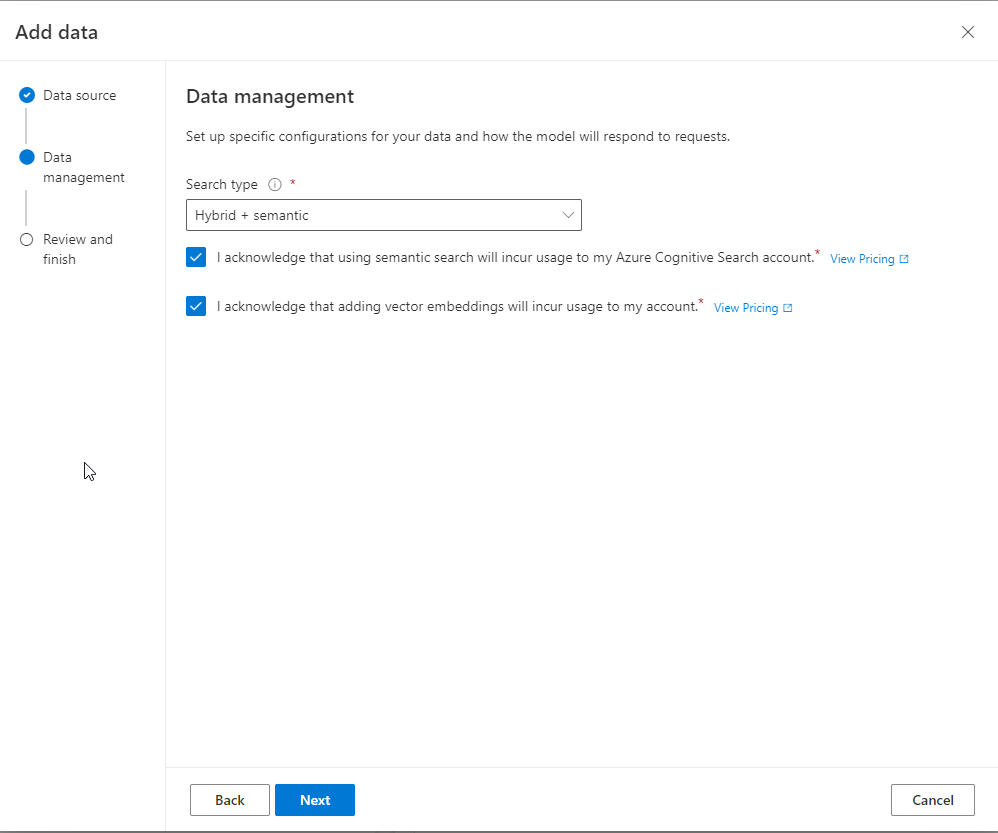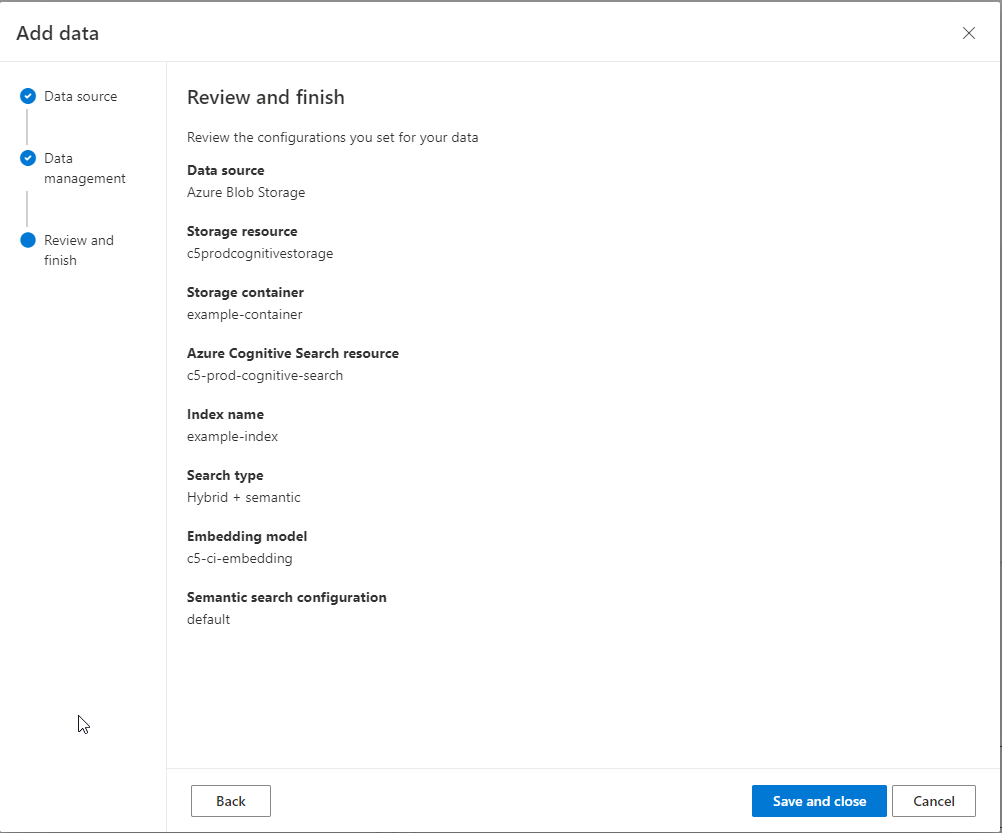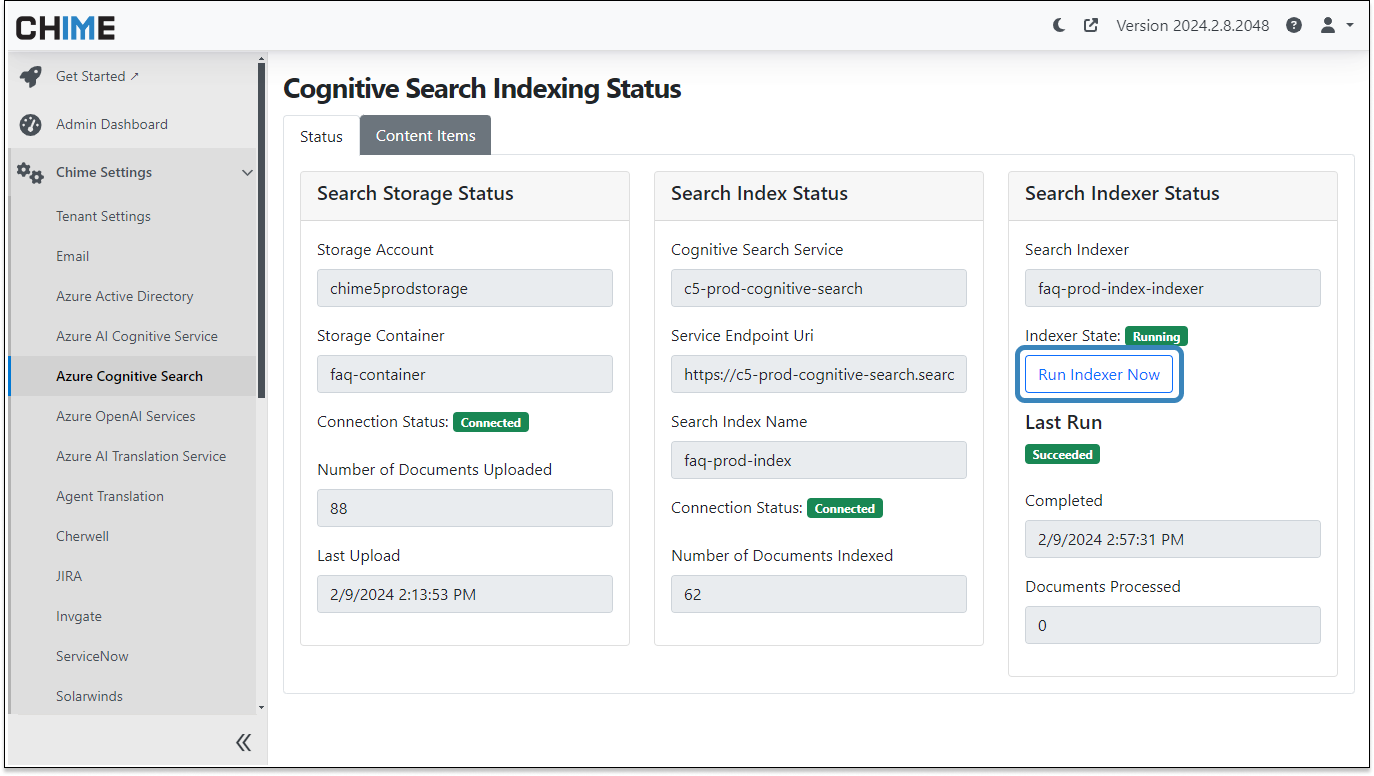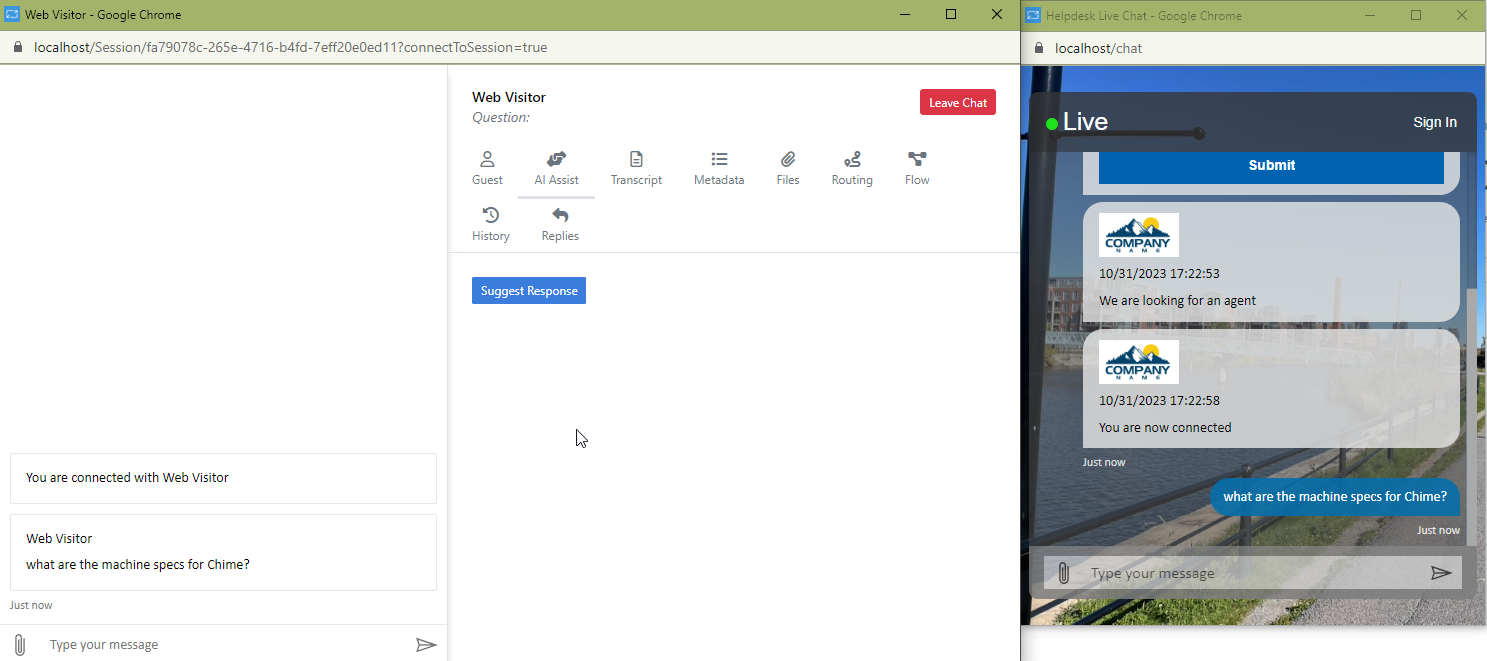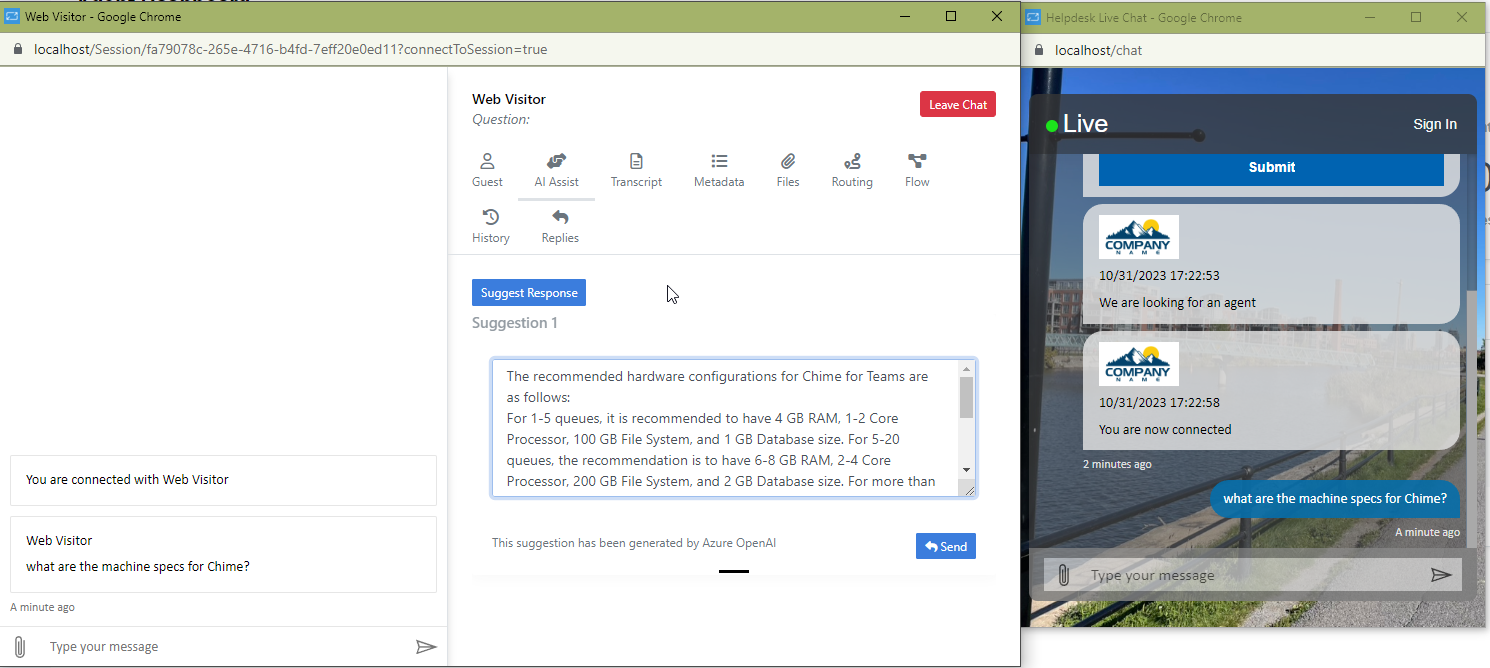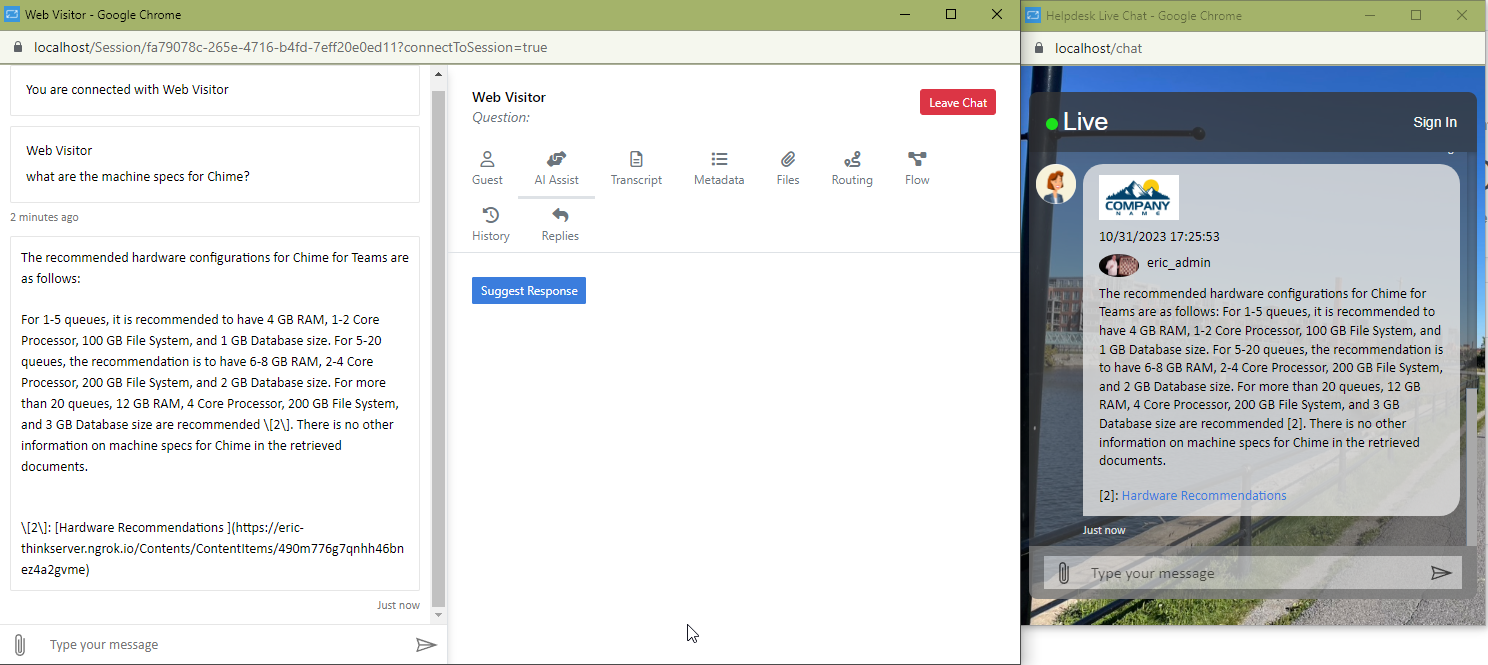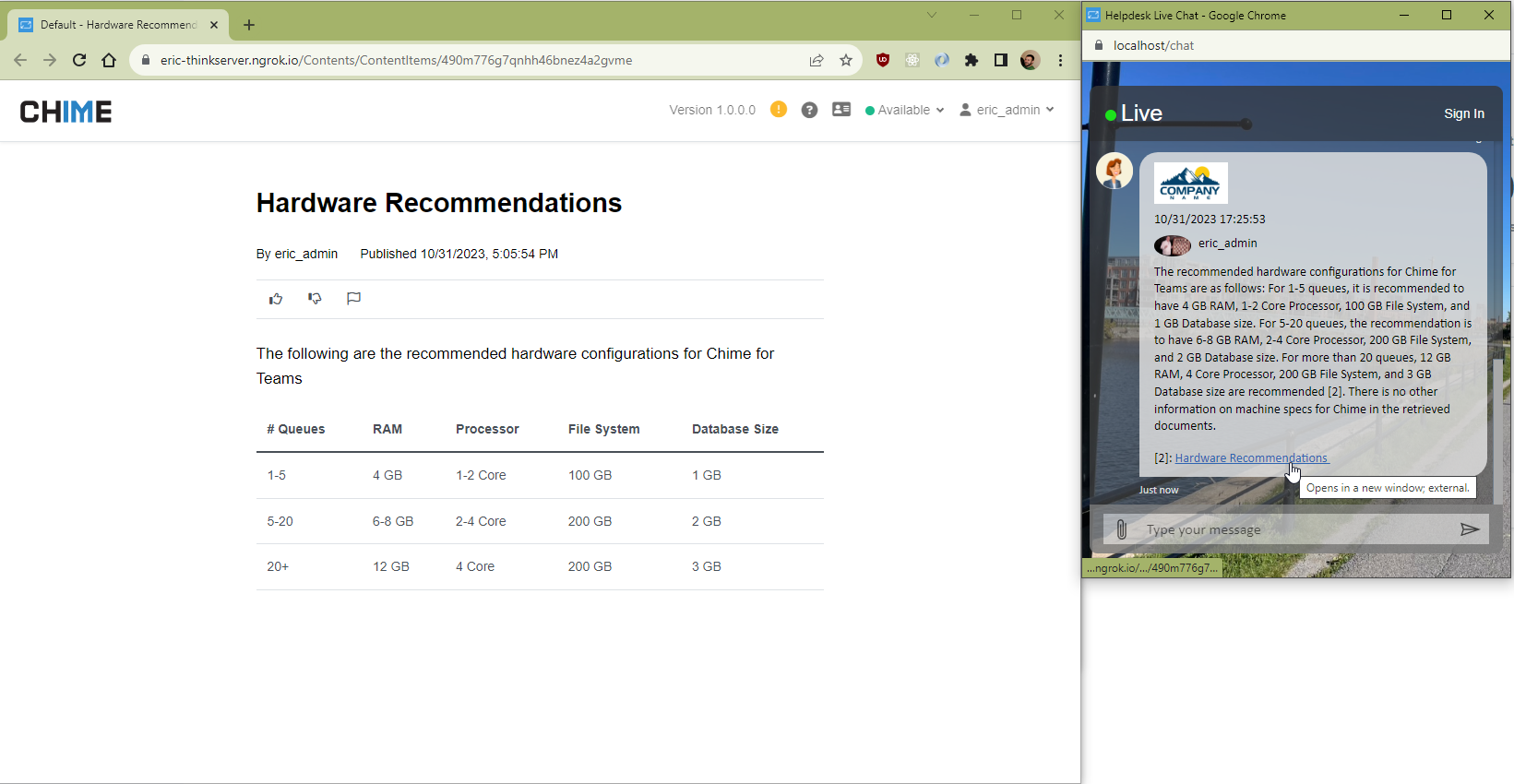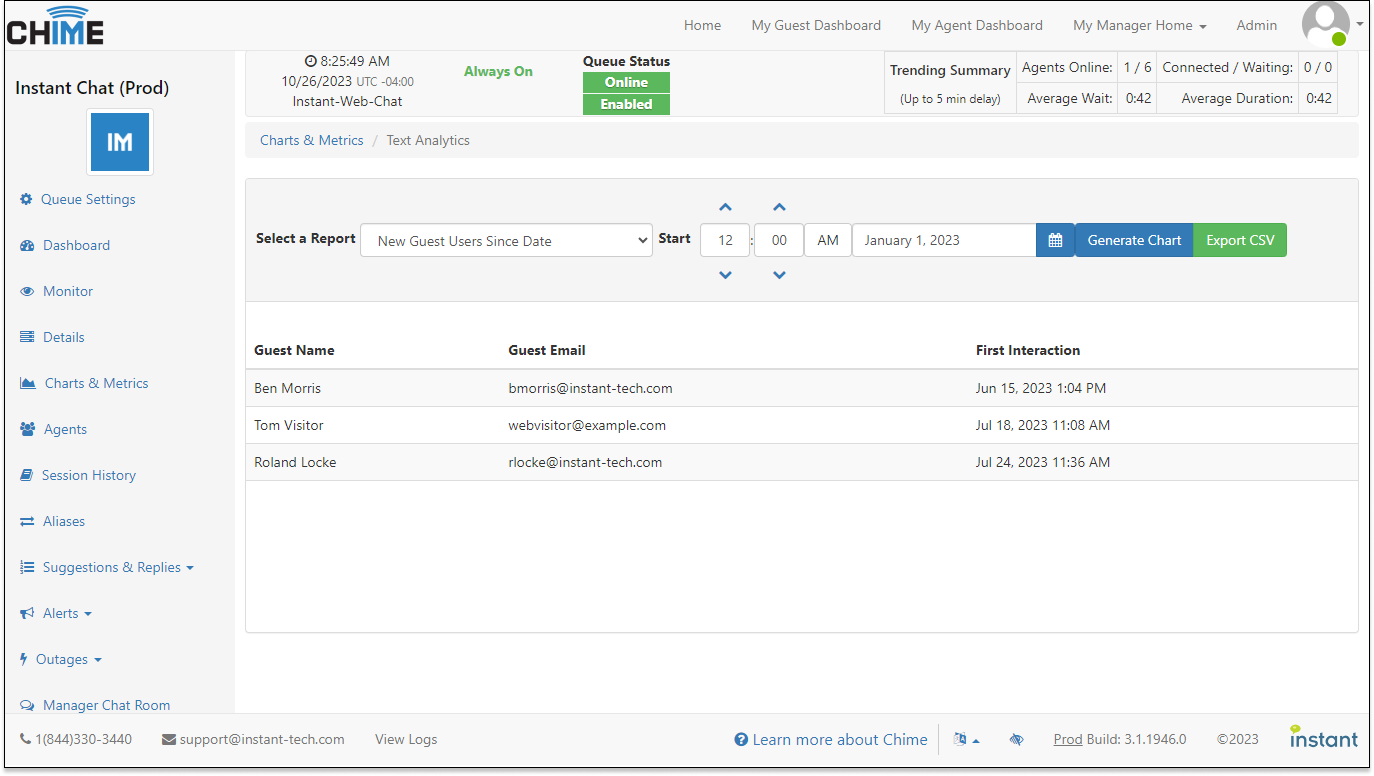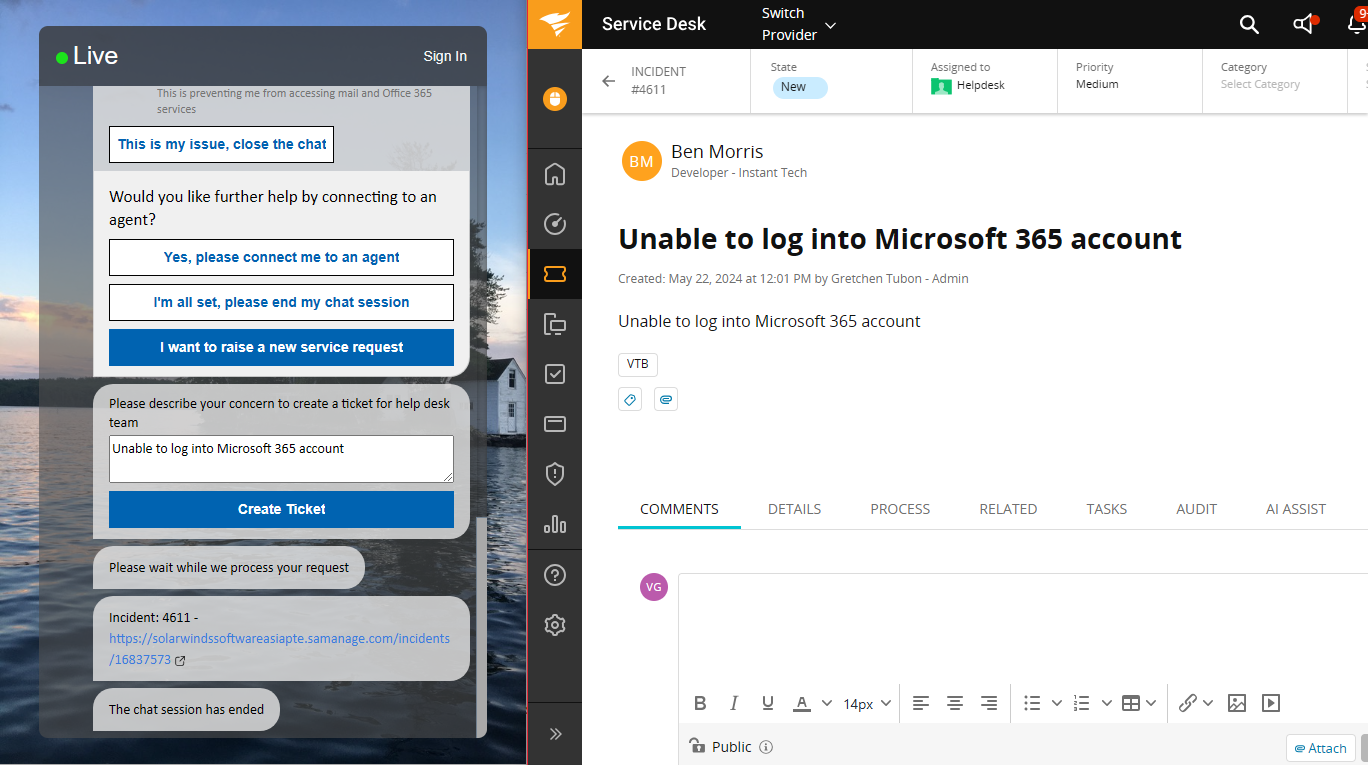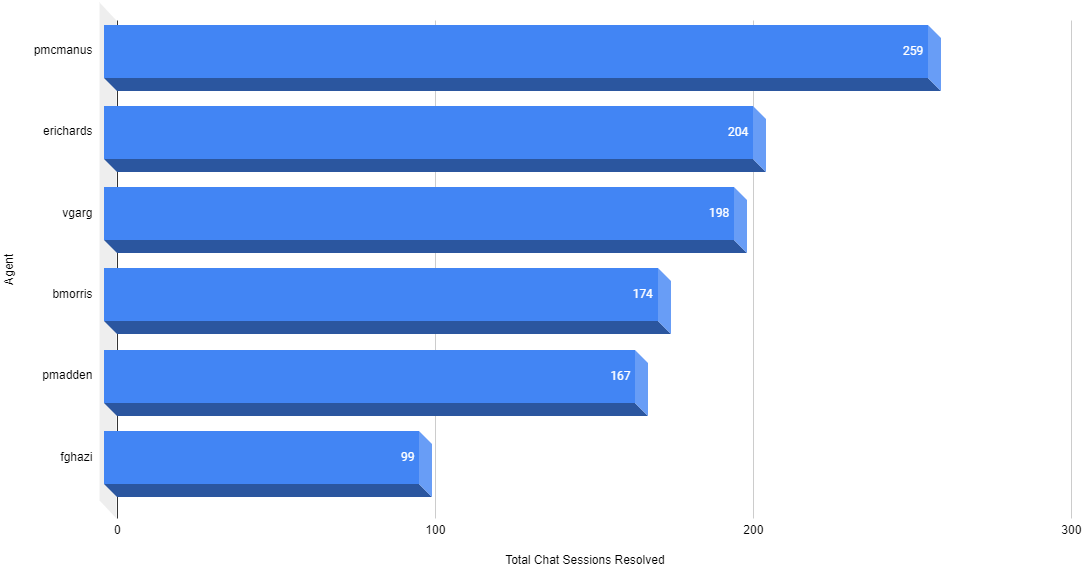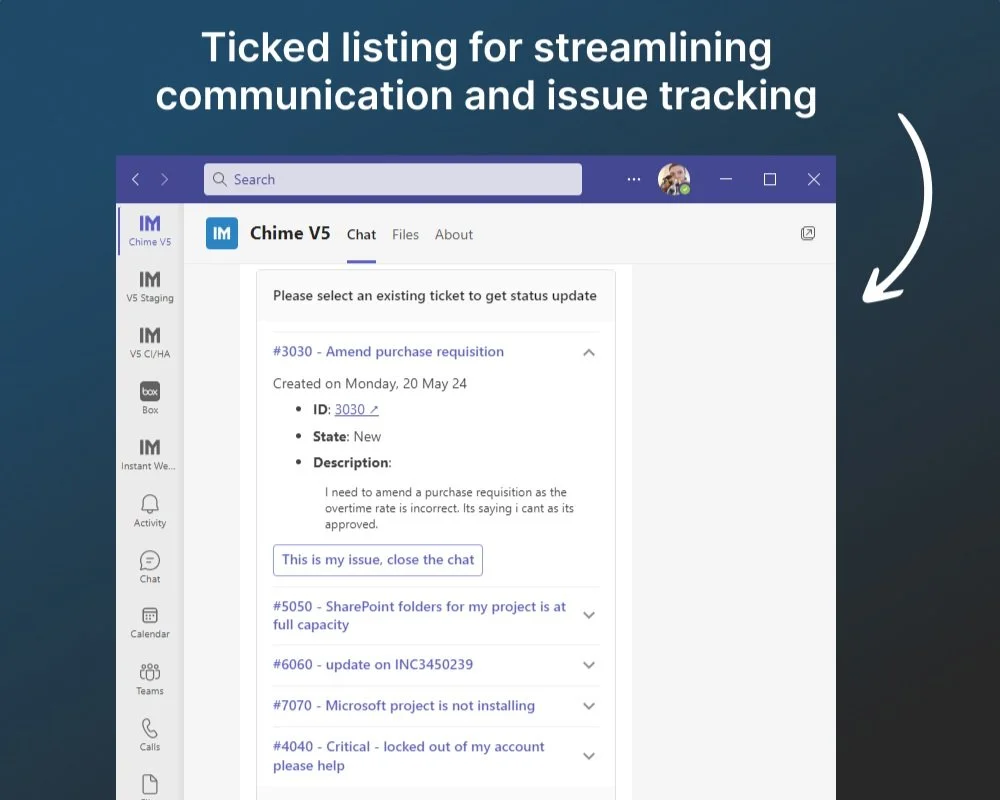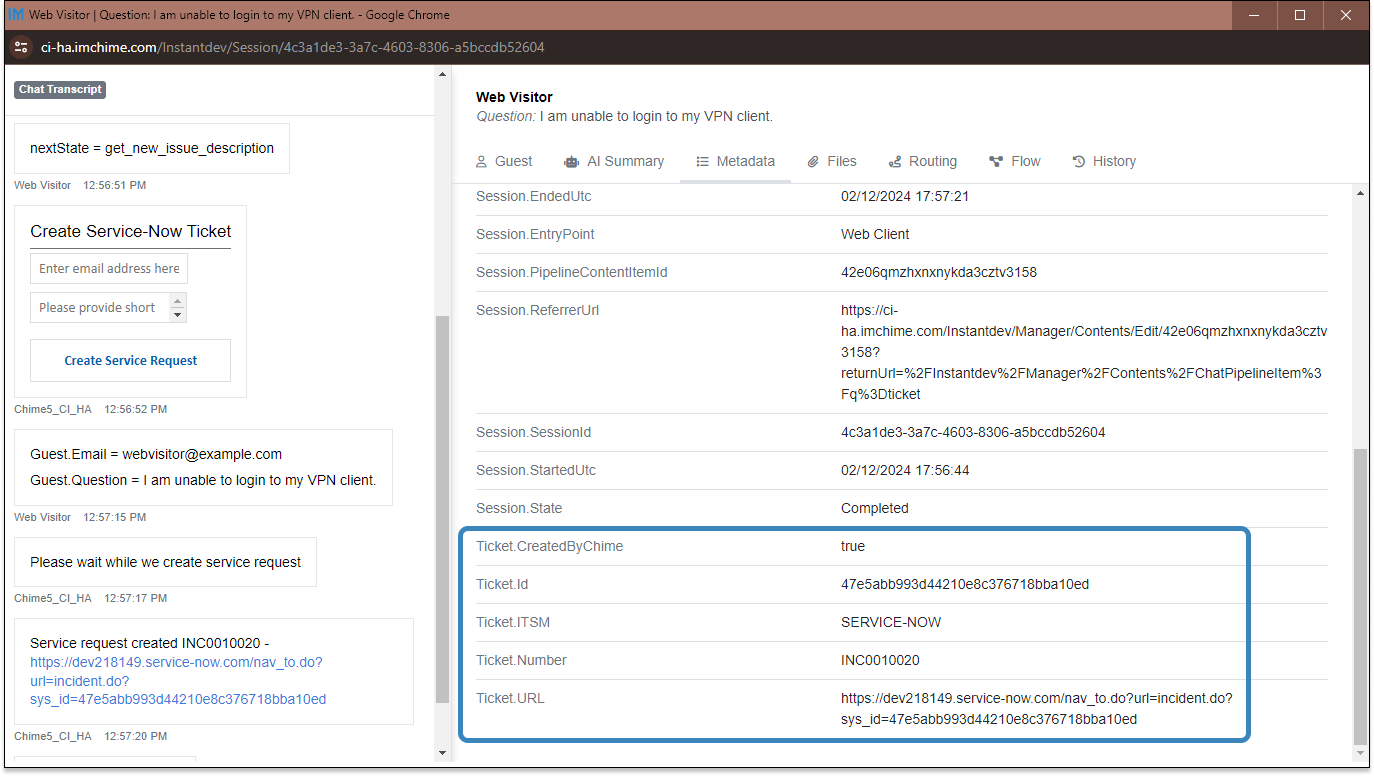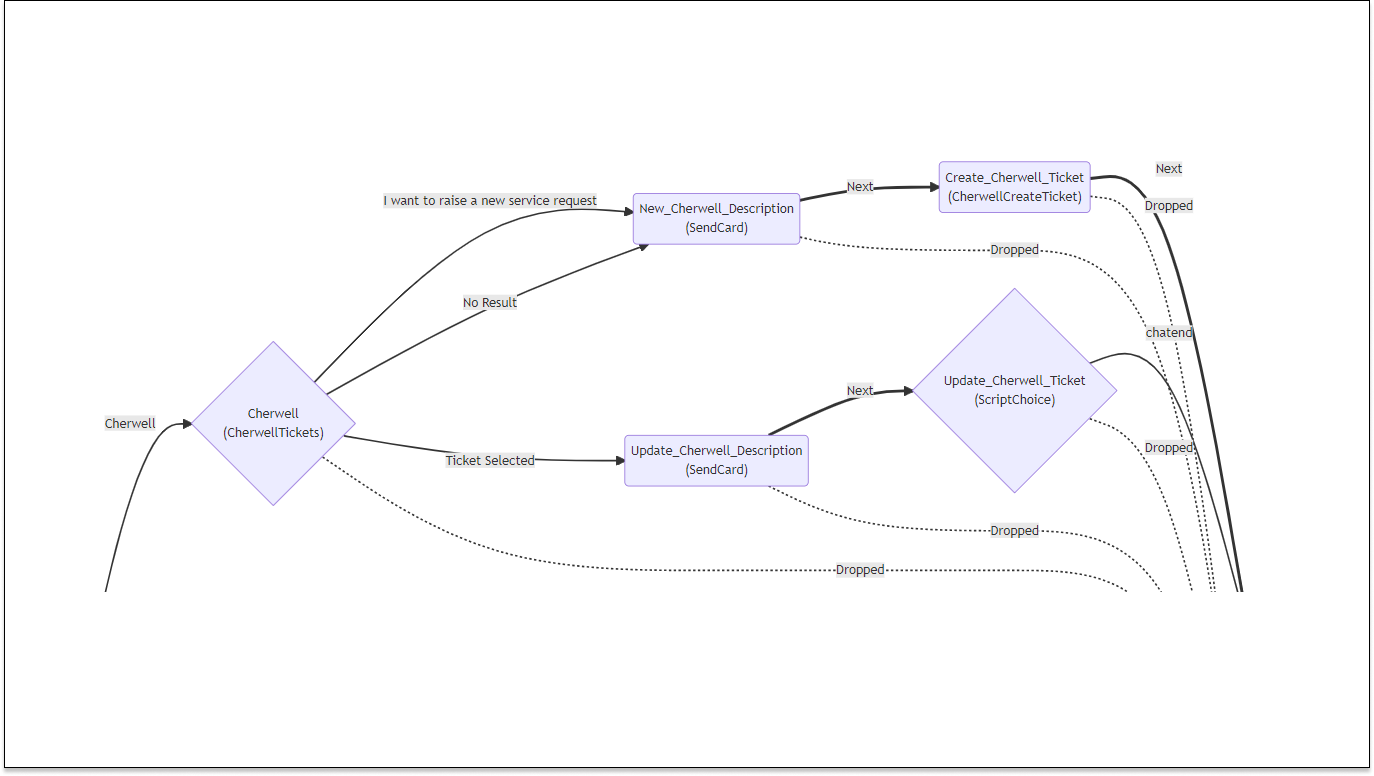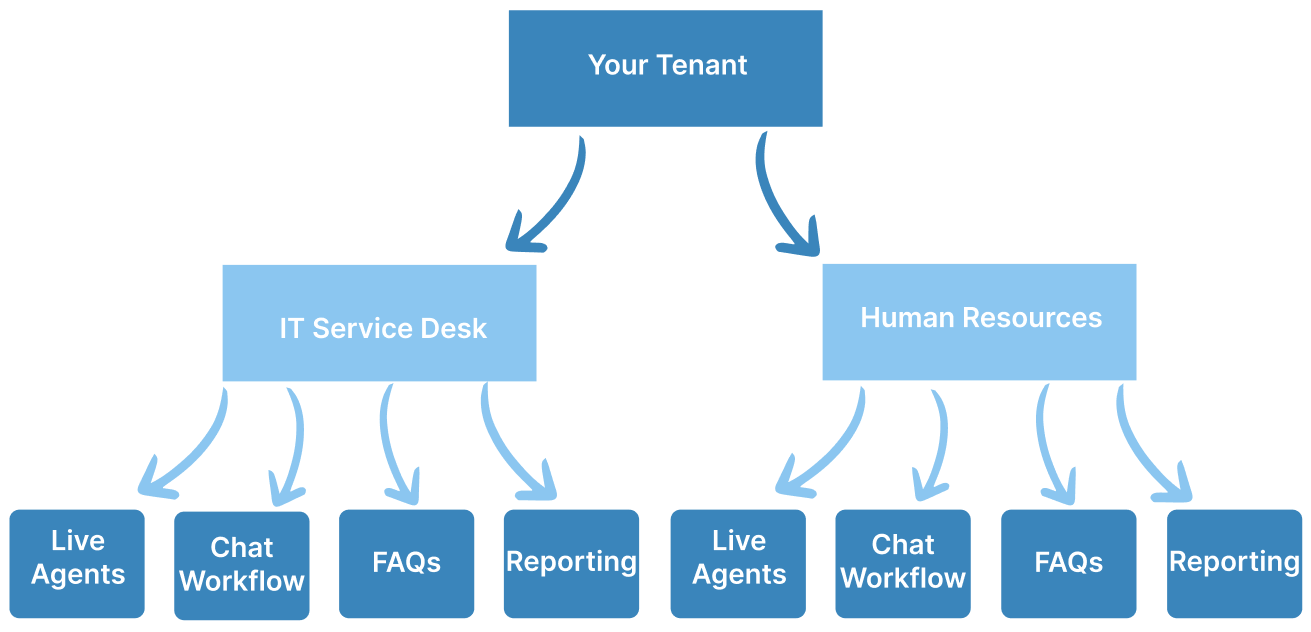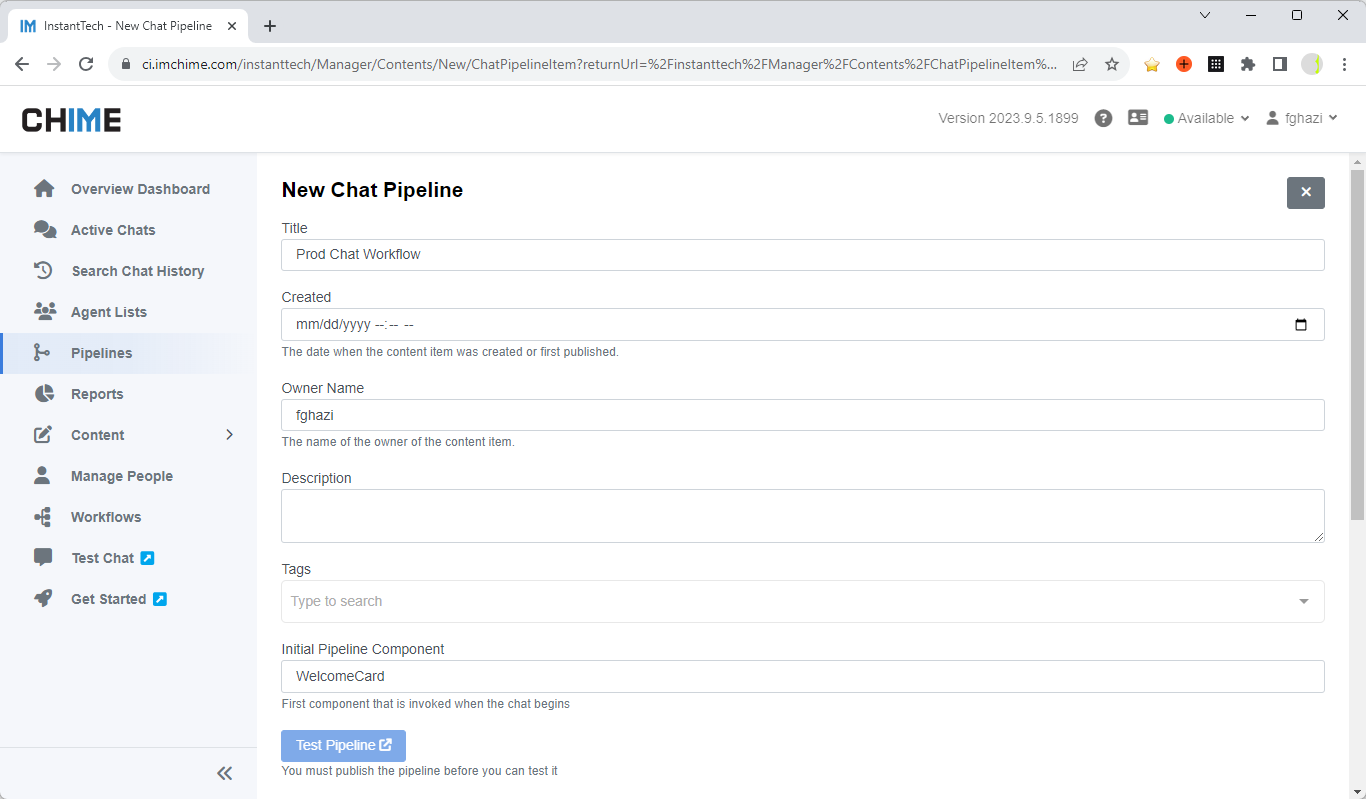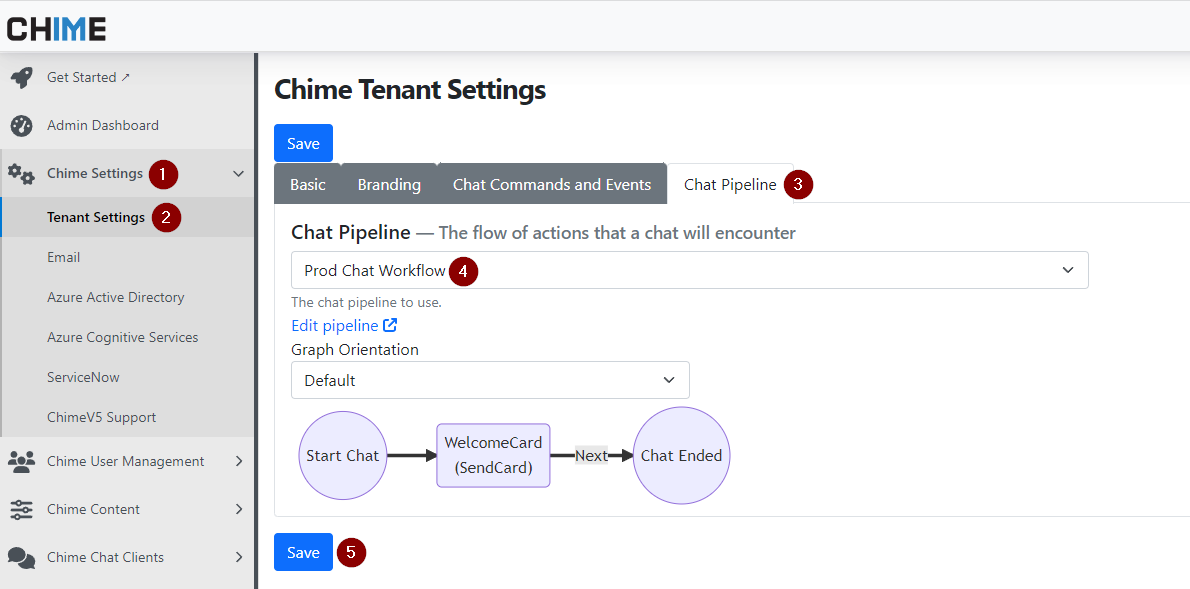All Metadata Values Available in Chime
View The Latest Set Of Metadata Variables
This will cover all available metadata variables that are usable for reporting, adaptive cards, standard replies, and outages.
Guest Variables
| Variable Name | Description | Example Values |
|---|---|---|
| Guest.AadObjectId | Guest user's Active Directory/Entra User Object ID | e6a2b68c-2cdf-4b83-abea-f29f710aea0c |
| Guest.ChannelId | Channel Guest is coming in on (directline or msteams) | msteams |
| Guest.Email | Email of the Guest | bsmith@example.com |
| Guest.GivenName | First/Given name of the Guest | Bob |
| Guest.Id | Chime ID of the Guest | dl_bsmith@00000000-0000-0000-0000-000000000000 |
| Guest.IsNew | True or False for if this is the first time the Guest is using Chime | true |
| Guest.Locale | Location and Language settings of the Guest | en-US |
| Guest.Name | Full name of the Guest | Bob Smith |
| Guest.Question | Question of the Guest | Hi I need to reset my email password |
| Guest.Surname | Last/Surname of the Guest | Smith |
| Guest.TenantId | Tenant ID for the organization of the Guest | |
| Guest.TenantName | Tenant name that the Guest is coming into | Example Inc |
| Guest.UserPrincipleName | Active Directory/Entra UPN of the Guest (username and domain in an email address format) | bsmith@example.com |
| Guest.Country | Country of the Guest | US |
| Guest.Timezone | Timezone of the Guest | America/New_York |
| Guest.Platform | Operating system/platform the Guest is using | Windows |
Session Variables
| Variable Name | Description | Example Values |
|---|---|---|
| Session.EndedUtc | Date and time that the chat session ended in UTC timezone | 01/04/2024 17:42:47 |
| Session.ChatID | Directline Chat ID for the current session | 8bVNRWxnMRvFBiUj7VhFAB-us |
| Session.State | State name that the chat session is in | Completed |
| Session.Status.IsResolved | Boolean for if the chat session was resolved or not | True |
| Session.Status.ResolutionNotes | Can be used to provide notes about the chat resolution by the pipeline or by Agents after the chat ended | Guest was able to use ChatGPT assist to answer their questions and resolve this chat |
| Session.Status.ResolvedByAgentId | Agent Id for agent that resolved the chat session | 47ab169g1vp5hzm09914stk55g |
| Session.Status.ResolvedByAgentName | Lists out the name/names of Agents that were in the chat when it was resolved | John Doe, Jane Doe |
| Session.Status.ResolvedByType | Describes which Pipeline Item the chat was at when it was resolved | Agent, ChatGPT, AI Assist |
| Session.WasConnectedWithAgent | Boolean for if the Guest was connected to an Agent in the chat session | true |
| Session.deflected | Boolean for if the chat session was deflected | True |
| Session.deflectedBy | Describes which Pipeline Item the chat was at when it deflected | FAQ Lookup |
| Session.SessionId | Chime's internal Session ID for the chat session | 3b810491-a2d3-4a2a-95e9-fc75e7107819 |
| Session.StartedUtc | Date and time that the chat session started in UTC timezone | 05/27/2022 133429 |
| Session.ReferrerUrl | If the chat was started from webclient, this is the URL of the page it came from | https://example.com/ |
| Session.EntryPoint | Method the Guest used to start the chat session, Teams or Webclient | Webclient |
| Session.CurrentPipelineStage.Name | Name of the Pipeline Item that the chat session is on currently | connectToAgent |
| Session.CurrentPipelineStage.Type | Type of Pipeline Item that the chat session is on | ConnectedToAgentState |
| Session.PipelinePath | List of JSON objects that cover each Pipeline Item the chat has routed through | [ { "ToState": "welcomeMessage", "ToStateType": "SendCardState", "FromState": "StartChat", "Timestamp": "2024-01-04T18:18:11.3745466+00:00" }, { "ToState": "connectToAgent", "ToStateType": "ConnectedToAgentState", "FromState": "welcomeMessage", "FromStateType": "SendCardState", "Timestamp": "2024-01-04T18:19:11.3745508+00:00" }] |
| Session.SkillTags | Comma seperated list of any Skill Tags that are linked to the chat session | Office365, Email |
| Session.SkillTagList | List format of any Skill Tags that are linked to the chat session | [ "Office365", "Email" ] |
| Session.PickChatUrl | URL the Agent can use to pick/accept the chat session | https://app.imchime.com/Example/Session/00000000-0000-0000-0000-000000000000?connectToSession=true |
| Session.IsConnectedToAgent | Dynamic boolean for if the Guest is connected with one or more Agents | true |
| Session.IsWaiting | Dynamic boolean for if the Guest is currently in the "Conect to Agent" Pipeline Item and waiting for an Agent to accept their chat session | false |
| Session.StartedWaitingAt | Date and time the chat session went into the Waiting state (Guest is routing to an Agent) | 2024-01-04T18:20:05.1769764+0000 |
| Session.ConnectedToAgentAt | Date and time the chat session went into the Connected state (Agent picked up Guest's chat) | 2024-01-04T18:20:11.3769773+0000 |
| Session.WaitTime | The current ammount of time the chat session has been in the Waiting state (JSON object) | { "String": "0:00:06.2", "Seconds": 6, "Minutes": 0, "TotalSeconds": 6.2, "TotalMinutes": 0.10333333333333333 } |
| Session.WaitTime.String | Wait time as a string | 0:00:06.2 |
| Session.WaitTime.Seconds | Number of seconds the chat has been waiting (not total seconds) | 6 |
| Session.WaitTime.Minutes | Number of minutes the chat has been waiting | 0 |
| Session.WaitTime.TotalSeconds | Total number(decimal) of seconds the chat session has been waiting | 6.2 |
| Session.WaitTime.TotalMinutes | Total number(decimal) of minutes the chat session has been waiting | 0.10333333333333333 |
| Session.ConnectedTime | The current ammount of time the chat session has been connected to an Agent (JSON object) | { "String": "0:03:42", "Seconds": 42, "Minutes": 3, "TotalSeconds": 222, "TotalMinutes": 3.7 } |
| Session.ConnectedTime.String | Connected time as a string | 0:03:42 |
| Session.ConnectedTime.Seconds | Number of seconds the chat has been connected (not total seconds) | 42 |
| Session.ConnectedTime.Minutes | Number of minuntes the chat has been connected | 3 |
| Session.ConnectedTime.TotalSeconds | Total number(decimal) of seconds the chat session has been connected | 222 |
| Session.ConnectedTime.TotalMinutes | Total number(decimal) of minutes the chat session has been connected | 3.7 |
| Session.AverageWaitTime | The average wait time of all sessions over the last 24 hours [Total wait time / number of sessions] (JSON object) | { "String": "0:01:11", "Seconds": 11, "Minutes": 1, "TotalSeconds": 71, "TotalMinutes": 1.1833333333333333 } |
| Session.AverageWaitTime.String | Average wait time as a string | 0:01:11 |
| Session.AverageWaitTime.Seconds | Number of seconds for the chats average wait time (not total seconds) | 11 |
| Session.AverageWaitTime.Minutes | Number of minutes for the chats average wait time | 1 |
| Session.AverageWaitTime.TotalSeconds | Total number(decimal) of seconds for the chats average wait time | 71 |
| Session.AverageWaitTime.TotalMinutes | Total number(decimal) of minutes for the chats average wait time | 1.1833333333333333 |
| Session.AverageWaitTimeLastHour | The average wait time of all sessions over the last hour [Total wait time / number of sessions] (JSON object) | { "String": "0:01:14", "Seconds": 14, "Minutes": 1, "TotalSeconds": 74, "TotalMinutes": 1.2333333333333334 } |
| Session.AverageWaitTimeLastHour.String | Average wait time from the last hour as a string | 0:01:14 |
| Session.AverageWaitTimeLastHour.Seconds | Number of seconds for the chats average wait time from the last hour (not total seconds) | 14 |
| Session.AverageWaitTimeLastHour.Minutes | Number of minutes for the chats average wait time from the last hour | 1 |
| Session.AverageWaitTimeLastHour.TotalSeconds | Total number(decimal) of seconds for the chats average wait time from the last hour | 74 |
| Session.AverageWaitTimeLastHour.TotalMinutes | Total number(decimal) of minutes for the chats average wait time from the last hour | 1.2333333333333334 |
| Session.ExpectedWaitTime | How much longer the Guest is expected to wait [AverageWaitTime - WaitTime] (JSON object) | { "String": "0:01:04.8", "Seconds": 4, "Minutes": 1, "TotalSeconds": 64.8, "TotalMinutes": 1.08 } |
| Session.ExpectedWaitTime.String | Expected wait time as a string | 0:01:04.8 |
| Session.ExpectedWaitTime.Seconds | Number of seconds the chat is expected to wait (not total seconds) | 4 |
| Session.ExpectedWaitTime.Minutes | Number of minutes the chat is expected to wait | 1 |
| Session.ExpectedWaitTime.TotalSeconds | Total number(decimal) of seconds the chat is expected to wait | 64.8 |
| Session.ExpectedWaitTime.TotalMinutes | Total number(decimal) of minuntes the chat is expected to wait | 1.08 |
| Session.ExpectedWaitTimeLastHour | How much longer the Guest is expected to wait [AverageWaitTimeLastHour - WaitTime] (JSON object) | { "String": "0:01:07.8", "Seconds": 7, "Minutes": 1, "TotalSeconds": 67.8, "TotalMinutes": 1.13 } |
| Session.ExpectedWaitTimeLastHour.String | Expected wait time from the last hour as a string | 0:01:07.8 |
| Session.ExpectedWaitTimeLastHour.Seconds | Number of seconds the chat is expected to wait from the last hour (not total seconds) | 7 |
| Session.ExpectedWaitTimeLastHour.Minutes | Number of minutes the chat is expected to wait from the last hour | 1 |
| Session.ExpectedWaitTimeLastHour.TotalSeconds | Total number(decimal) of seconds the chat is expected to wait from the last hour | 67.8 |
| Session.ExpectedWaitTimeLastHour.TotalMinutes | Total number(decimal) of minuntes the chat is expected to wait from the last hour | 1.13 |
| Session.WaitMessageCount | Number of wait messages that have been sent to the Guest while looking for an Agent | 2 |
| Session.ConnectedAgents | List of JSON objects for the Agents that connected to the chat session | [ { "Name": "Jim Jones", "FirstName": "Jim", "LastName": "Jones", "Email": "jjones@example.com", "Connected": "05/27/2022 13:34:56", "ID": "47ab169g1vp5hzm09914stk55g", "ProfileImageUrl": "https://app.imchime.com/Example/media/media/_branding/default_profile.jpg"},{ "Name": "Carol Johnson", "FirstName": "Carol", "LastName": "Johnson", "Email": "cjohnson@example.com", "Connected": "05/27/2022 13:37:56", "ID": "47ab169g1vp5hzm09914stk44g", "ProfileImageUrl": "https://app.imchime.com/Example/media/media/_branding/default_profile.jpg"} ] |
| Session.NumberOfConnectedAgents | The number of Agents currently connected to the chat session | 2 |
| Session.AvailableAgentCount | The number of Agents who are currently online and able to accept the chat session | 3 |
| Session.WaitingGuestCount | The number of Guests who are currently waiting for an Agent to accept their chat session | 4 |
| Session.PositionInQueue | The position in queue that the current chat session is in (how many Guests will get connected to an Agent before this Guests chat session) | 1 |
Agent Variables
| Variable Name | Description | Example Values |
|---|---|---|
| Agent.Name | Full name of the current Agent | Jim Jones |
| Agent.FirstName | First name/Given name of the current Agent | Jim |
| Agent.LastName | Last name/Surname of the current Agent | Jones |
| Agent.Email | Email of the current Agent | jjones@example.com |
| Agent.ProfileImageUrl | Media library URL location of the Agent's profile image | /media/_branding/default_profile.jpg |
| Agent.Connected | Date and time that the Agent connected to the Guest's chat session | 05/27/2022 13:34:56 |
| Agent.ID | Agent ID for the current Agent | 47ab169g1vp5hzm09914stk55g |
Sender Variables
| Variable Name | Description | Example Values |
|---|---|---|
| Sender.Name | Full name of the current Agent | Jim Jones |
| Sender.FirstName | First name/Given name of the current message sender | Jim |
| Sender.LastName | Last name/Surname of the current message sender | Jones |
| Sender.Email | email of the current message sender | jjones@example.com |
| Sender.ProfileImageUrl | Media library URL location of the message sender's profile image | /media/_branding/default_profile.jpg |
| Sender.Locale | Locale of the current message sender | en-US |
Routing Variables
| Variable Name | Description | Example Values |
|---|---|---|
| Routing.AgentList.Name | Name of the agent list | Service Desk |
| Routing.AgentList.Id | ContentItemId of the agent list | 4m49qcqycbygv3m88g80r7aw51 |
| Routing.AgentList.Type | Type of the agent list => [All, Tagged, Selected] | Selected |
| Routing.Mode | Which routing mode is configured for the agent list | RoundRobin |
Chatbot Variables
| Variable Name | Description | Example Values |
|---|---|---|
| Chatbot.ConnectedAt | Date and time when the AI chatbot connected with the guest | 2024-01-17T09:37:11.3745267Z |
| Chatbot.DisconnectedAt | Date and time when the AI chatbot disconnected from the guest | 2024-01-17T16:41:53.3578965Z |
| Chatbot.Escalated | True or false if the chat was escalated to a live agent | false |
| Chatbot.Deflected | True of false if the chat was deflected by the chatbot | true |
AI Summary Metrics
| Variable Name | Description | Example Values |
|---|---|---|
| AI.Summary.Title | AI generated title summarizing the chat session | Installation and configuration of AI-Enabled Help Desk Instant Chiume V5 |
| AI.Summary.Issue | AI generated summary of the initial issue the guest comes in with | The customer wants to know how to install the AI-enabled help desk, Chime V5. |
| AI.Summary.Resolution | AI generated summary of how the chat was resolved between the Agent and Guest | The agent informed the customer that they can install the application from the Microsoft Teams App Store and configure the tenant. No custom Azure resources are required as all necessary resources are included in the deployment. The customer successfully installed the application. |
| AI.Summary.Narrative | AI generated summary of the main important points covered in the chat session | The transcript is about how to install the AI-enabled help desk, Chime V5, from the Microsoft Teams App Store. It explains that the tenant can be configured with a unique database instance, tenant URL, and tenant administrator, and that no custom Azure resources are required. The Web Visitor successfully installed the software. |
Outages
| Variable Name | Description | Example Values |
|---|---|---|
| Session.OutageId | Content ID of the Outage the guest selected | 43mbkc86gc1vjtvt6427cd0jw9 |
| Session.OutageTitle | Title of the Outage the guest selected | Email services down from 5:30 to 7:15 for maintenance |
| Session.SubscribeToOutage | Did the guest subscribe to receive update notifications about the outage? | true |
Ticketing
| Variable Name | Description | Example Values |
|---|---|---|
| Ticket.Id (GUID) | ID of the ticket created | efed3b82-6d83-46fd-b80e-1da34d9a90ff |
| Ticket.Number | Ticket number created in the ticketing system | 0938479538 |
| Ticket.CreatedByChime | Was the ticket created by Chime? (true or false) | true |
| Ticket.URL | URL of the ticket | https://ticketingsystem.com/tickets/0938479538 |
| Ticket.ITSM | Name of the ticketing platform the ticket is on | (JIRA, SERVICE-NOW, SOLARWINDS, JIRA or CHERWELL) |
System Variables
| Variable Name | Description | Example Values |
|---|---|---|
| System.CurrentTimeUTC | Current date and time in UTC time zone | 2024-01-04T18:20:11.3745267Z |
| System.CurrentTime | Current time in local time zone | 14:20:11+0000 |
| System.CurrentDate | Current date in your local time zone | 2024-01-04 |
| System.CurrentDateTime | Current date and time in your local time zone | DATE(2024-01-04) TIME(14:20:11+0000) |
| System.BaseUrl | Base URl of your Chime V5 tenant | https://app.imchime.com/Example |
| System.Tenant | Name of your Chime V5 tenant | Example |
| System.PipelineName | Name of the Pipeline you are routing in | Self Service Pipeline |
| System.MediaUrl | URL of your tenant's Media Library | https://app.imchime.com/Example/media/ |
Maximize InvGate Ticketing Integration To Solve Employee Problems
Add Ticketing Integration To Service Desk Chat
Add a SaaS chat channel to help solve employee problems. Enable employees to search FAQs, solve common problems, route to agents, and integrate with InvGate as the primary ticketing system. Quickly solve employee problems using chat - and maximize your existing investment in InvGate.
The Invgate Ticket Listing Pipeline Action is a powerful feature designed to fetch open incidents for a seeker and associate them with ongoing chat sessions. This integration enhances collaboration and simplifies issue tracking for support teams.
Configuration
To get started, your tenant admin needs to specify the Invgate instance URL and login credentials under Chime Configuration -> Invgate.
Configure Invgate ticketing Instance URL and credentials for your service desk
Apply your credentials on a tenant level to enable the Invgate features
Invgate Ticketing Features
To leverage the Invgate ticketing integration, ensure the following features are enabled:
Invgate.Ticketing
Invgate.Pipeline.TicketListing
Pipeline Configuration
View the different enterprise service desk actions for Invgate ticketing
Integrate Invgate into your service desk to simplify and improve ticket management
Prompt: Define the title that appears on the ticket listing card.
Button Associated With Card: Specify what is written on the button to display on card.
No Result State: Specify the pipeline key for seekers if no incidents are found.
Lookup tickets using Session Meta Data Field: Configure the field for searching incidents, commonly the seeker's email address.
Next Stage: Set the pipeline key for seekers after associating an incident with the session.
Options: Customize additional pipeline navigation options as needed.
Seeker Experience
The pipeline displays open incidents, allowing seekers to click on an option to reveal essential details such as links, descriptions, and last updated timestamps.
View Invgate tickets in your AI powered Teams chat
View tickets and associate them with your service desk chat session all from within Teams
Seekers can seamlessly associate incidents with chat sessions by selecting the relevant option, progressing to the next stage as configured in the pipeline.
Invgate Create or Update Ticket Pipeline Action
The Invgate Create or Update Ticket Pipeline Action empowers users to create new tickets or update existing ones. It assigns tickets to advisors and pushes chat transcripts to ticket records.
Invgate Ticketing Features
Invgate.Ticketing
Invgate.Pipeline.CreateTicket
Pipeline Configuration
Define Invgate fields for easy ticket creation within your service desk chat
Simplify the process of creating or updating tickets when chatting with your help desk
Notify seeker Invgate ticket is about to get created/updated: Customize the message to notify the seeker when a ticket is about to be created or updated.
Provide seeker Invgate ticket details: Configure the message to send seekers, including ticket number, ID, and URL.
Provide incident category: Configure the incident category Id
Provide incident priority: Configure the incident priority Id: 1 (Low), 2 (Medium), 3 (High)
Provide incident type: Configure the incident type Id
Assign incident to group: Configure the group Id
Evaluate JavaScript for Accessing Invgate Tickets
The Evaluate JavaScript action in the pipeline allows for versatile methods to access Invgate ticketing API calls, providing a convenient way to interact with tickets directly from Invgate chat sessions.
Invgate Ticketing Features
Before getting started, ensure the following feature is enabled:
- Invgate.Ticketing
Script Method - getInvgateTickets('seekerEmailAddress'): To retrieve a list of Invgate tickets, utilize the getInvgateTickets script call, passing the seeker's email address as a parameter.
// Get tickets
var tickets = getInvgateTickets("${Guest.Email}");
var ticketsArray = JSON.parse(tickets);
// Perform operations on ticket records
sendReply("Count of tickets: " + ticketsArray.length);Script Methods for Ticket Manipulation: Leverage JavaScript Invgate helper calls to create and update tickets:
getInvgateTicket(seekerEmailAddress)updateInvgateTicketDescription(ticketId, description)assignInvgateTicket(agentEmailAddress)updateInvgateTicketTitle(ticketId, title)
Seeker Experience
The pipeline notifies seekers about impending ticket actions and provides them with necessary details, ensuring a transparent and user-friendly experience.
Ask questions and report issues in AI powered chat then easily create or update Invgate tickets
Streamline the process of reporting an issue and a help desk chat and creating or updating a ticket
Conclusion
Invgate's ticketing integration simplifies incident management, allowing organizations to easily handle and respond to incidents. It enables support teams to access, manage, and respond to tickets seamlessly, facilitating efficient communication and streamlining the support experience for users. By integrating Invgate into your workflow, you can optimize ticket management and enhance your incident management capabilities. Discover these features to fully leverage Invgate on your platform.
Related Items
To further enhance your understanding and utilization of the Invgate integration in Chime, here are some related resources:
Enhance Content Security With Role-Based Security in your Service Desk
Select What Roles Can View Specific Content
Safeguarding data is crucial and implementing effective access control for sensitive information is essential. Utilize the role-based authorization feature to address this need. This way, you make sure only the right people can access sensitive information.
Step 1: Navigate To A Content Item
First you will want to navigate to the content item you would like to set up role based access for. Common content items include FAQs, Pages, etc.
Step 2: Select the 'Security' Tab
When you open the 'Edit' content page navigate to the 'Security' tab at the top of the screen
Navigate to your service desk content’s security tab
The security tab is where role based access control is assigned
Step 3: Enabling Content Item Access Control
On the 'Security' tab select the check box to enable the content item access control. When selected it will show a list of roles.
Enable access control for a content item and select what roles in your service desk will have access
You can assign multiple roles for the same content item
Step 4: Choosing Roles for Access Control
From the list of displayed roles, make a selection.Choose the specific role that aligns with your security requirements. Once selected, only individuals with that role will have the privilege to view the content.
Common Roles in Chime V5:
Anonymous - Open access for anyone
Authenticated - Limited to individuals who have logged in or been authenticated
Agent - Exclusive access for agents only
Manager - Exclusive access for managers only
Administrator - Exclusive access for admins only
Role Hierarchy Clarification: When a Agent, Manager, or Admin role has been assigned it does not follow any role heirarchy. For example Admins will be unable to view content assigned exclusively to Agents or Managers.
Simplifying Login Domain Restrictions for your Service Desk
Define What Domains Have Access
This feature is designed to help you to control which Azure AD tenant can authenticate to your specified tenant. When logging in using Azure authorization, any Microsoft account user can log in, but only those within the designated 'Domains' will be able to authenticate and gain access to the tenant. Our step-by-step guide will provide you with all the necessary information to set up this feature and ensure that your tenant is secure and protected from unauthorized access.
Step 1: Accessing Login Domain Restrictions
Begin by navigating to the Chime User Management section. Look for the 'Login Domain Restrictions' option within the Admin menu. This is the starting point for configuring domain-specific access controls.
Step 2: Choosing Domain Access Options
Once in the 'Login Domain Restrictions' section, select the 'Allow Users From Only These Domains' option. This choice will enable you to specify the domains from which users are allowed to log in.
Settings Page for Login Domain Restriction
Allow one or more than one Azure AD tenant domain to login to your tenant
Step 3: Defining Allowed Domains
In the 'Allowed Domains' field, input the domains that should have access to your Chime tenant. Refer to the provided JSON data for the correct format. You can include multiple domains, each associated with a unique TenantId.
[
{
"DomainName": "Instant",
"TenantId": "00000000-0000-0000-0000-00000000000"
},
{
"DomainName": "Sandbox",
"TenantId": "00000000-0000-0000-0000-00000000000"
}
]
Step 4: Configuring Azure Active Directory
Move to Chime Settings > Azure Active Directory. Confirm that the TenantId is listed as 'common.' This setting is crucial for allowing users from other tenants to sign in, ensuring a broader scope of collaboration.
Azure AD Authentication Settings
Update or configure Azure AD Authentication settings, change App ID or change Tenant ID
Frequently Asked Questions (FAQs)
Can I add multiple domains in the 'Allowed Domains' field?
Yes, you can include multiple domains in the 'Allowed Domains' field. Ensure each domain follows the format specified in the JSON data provided in the setup guide.
How do I find my TenantId for Chime?
Refer to the JSON data provided in the setup guide. The TenantId is associated with each domain. Copy the relevant TenantId for configuration in Chime Settings > Azure Active Directory.
Note: If you face issues related to the redirect URL, follow the recommendation to add a new user from the tenant and register the user. This often resolves redirect URL concerns. In case issues persist, head to your Azure Portal and navigate to the Chime V5 app registration's redirect URL section. If the redirect URL for the specified tenant is not listed, manually add it for a comprehensive solution.
Create Real-Time Agent Chat Notifications For Your Teams Chat Channel
Add Incoming Chat Notifications To Your Chat Channel
Our platform is created to solve employee problems. Add a new chat channel, integrated with Microsoft Teams, and help resolve employee problems with your FAQs, integration with Microsoft SharePoint, or by using an advanced AI powered chatbot. Of course, if employees need to chat with your service desk, or HR department, then route to chat in real-time - and solve issues immediately.
This feature allows agents to receive real-time chat notifications in their Teams client when an employee’s chat request is routed to them, directly from the bot.
In this guide, we'll walk you through the setup process to ensure a seamless integration into your workflow.
Prerequisites
Before diving into the setup, ensure that you have the latest version of Chime V5 installed - or just install from the Microsoft Teams Store and start an evaluation.
Integration with Teams
Chime V5's real-time agent notifications are integrated into the features associated with routing inbound request to agents. Agents may receive notifications using a browser, via Microsoft Teams, or possibly using a Windows application. The Microsoft Teams channel webhook notification feature is also valuable and easy to configure.
Enable the chat notification feature to notify agents of new chat requests
The chat notification feature is provided as an Orchard feature and is configured using the standard Orchard admin UI
Agents can now receive notifications in their Teams client when a chat is routed to them, in addition to the existing webhook method for routing into a Teams Channel.
HR or IT Service Desk agents are now notified of chat requests using Microsoft Teams - so that they can quickly assist employees who need help
Build a chat based service desk using Microsoft Teams
User Settings Management
To enable these notifications, user settings must be configured to store the Teams ID and conversation ID reference for each agent. This information is added to the Orchard User record, similar to the setup for the Agent Profile.
User Settings in the Admin Area
In the Admin section, navigate to the user record, where a new "Teams Notifications" tab has been added. Here, administrators can manage Teams addresses for each user.
Enable service desk agents to receive chat requests
Configure agents to receive incoming chat notifications in Microsoft Teams
Create a chat based service desk - enable agents to help employees using Microsoft Teams
Build a chat based service desk using Microsoft Teams - here you just need to configure the notifications at the agent level
User Settings in Manager Area
For the Manager dashboard, a new section in the user page displays Teams notification settings. Managers can easily view and update this information when managing agents.
Use the agent profile to enable notifications in Microsoft Teams
Use the agent profile to enable notifications in Microsoft Teams - these notifications will be sent directly to the agent using MS Teams
User Settings for Agents
Agents can access their Teams notification settings on their Agent Dashboard Settings page. Additionally, buttons are available to Install Chime in Teams and Start Chat in Teams, facilitating the capture of Teams address information.
Our chat platform integrates into Microsoft Teams
Agents can control their own chat notification settings
Tenant-level Configuration
At the tenant level, administrators can configure additional settings to customize the Teams integration experience.
Tenant-wide enable/disable toggle: Easily enable or disable the feature for the entire tenant.
Override for the Teams App Id: Specify the App Id based on the installation method, ensuring seamless integration.
Adaptive Card Template: Customize the notification's appearance using an Adaptive Card Template.
Our chat platform uses Microsoft Adaptive Cards - including to send agent notifications
Microsoft adaptive cards are used in our chat platform - and we include the adaptive card designer - as well as adaptive card library
Sending Agent Notifications
With the setup complete, agents, having their Teams Addresses captured, will receive notifications in their Teams client when a chat is routed to them.
Example of sending a chat notification using Microsoft Teams
When you pick up a chat from within Teams it will open in a new browser tab
The implementation of this feature is seamlessly integrated into the Orchard Workflow events, requiring no changes to the chat pipeline. While it's not tied to Teams presence, agents need to have a Chime browser window open and be available to receive notifications.
Connect Service Desk To Teams Using Teams Workflow Integration
Broadcast Notifications Into A Teams Channel
Connect your enterprise service desk to Teams and receive notifications for agents
Link your service desk chat to a Teams channel and receive agent notifications to the channel
When employing Chime V5 pipeline activities, agents can receive notifications directly on their dashboard when new chat sessions arrive. By integrating Webhooks with Teams, these V5 workflows can be linked to a designated Teams channel, providing improved accessibility through broadcast notifications to Microsoft Teams.
Add Workflow for Webhook Requests to Your Teams Channel
Navigate to Your Teams Channel
Begin by navigating to the Teams channel where you want to receive broadcast notifications.
Select More Options Menu
In the chosen channel, click on the more options menu (three dots) located at the top-right corner.
Select Workflows
Navigate to Teams channel workflows
From the dropdown menu, select Workflows
Select “Post to a channel when a webhook request is received”
Select the “Post to a channel when a webhook request is received from the ‘Notify a team’ list
Click on the text of the list option to make a selection
Configure Workflow
Fill Out Workflow Name
Provide a meaningful name for the Incoming Workflow to easily identify its purpose. This will be the name that is displayed when a card is sent in the channel upon received webhook request.
Name your Workflow
Wait for your Microsoft Teams connection to verify before selecting Next
Create Workflow
Add the workflow to your Teams channel
Select the Add workflow button to add it to your channel and generate the Post request URL
Copy the newly generated Workflow URL
Once the URL is generated, click on the Copy button or manually highlight and copy the link.
Configure In Chime V5 Tenant
Navigate to Chime V5 Tenant
Open your Chime V5 tenant and access the chat pipeline.
Edit Chat Pipeline
Select the Edit option in the chat pipeline.
Connect to Agent Pipeline Item
Open the details for the Connect to Agent pipeline item.
Enable Webhook
Toggle the "Webhook Enabled" option to activate the webhook functionality.
Paste Webhook URL
Paste the Incoming Webhook URL into the ‘Connect to Agent’ chat flow stage
In the Webhook URL field, paste the previously copied URL from Teams.
Enable agent notification to Microsoft Teams using Webhook
Within the ‘Connect to Agent’ pipeline stage select the Webhook Enabled toggle to enable or disable channel notifications
User Experience for the Agent in MS Teams
View the Webhook Teams notifications for agents
Upon an incoming chat session, a broadcast notification is sent to the connected Teams channel
Related Content
Use Azure OpenAI And ChatGPT with Azure Cognitive Search
Create FAQ Chat App
Deploying a FAQ chatbot is a great way solve common issues and problems encountered by employees. Chime V5 provides a full FAQ system, with a chat service and connections to all Azure AI services. Deploy a Q&A chatbot, from the Microsoft Teams Store, to solve employee issues and immediately improve your existing service desk.
AI can create text, image, audio content, and produce enterprise FAQ chat bots and Q&A chat applications. Developers all across the world are incorporating AI into their applications for the benefit of their users. New AI models and SDKs pop out of the woodwork, it can be challenging for the enterprise to figure out how to get started and use it all especially when their curated content is located within SharePoint, ITSM knowledge bases or internal content management systems.
Microsoft Azure OpenAI offers high-performance AI models at a production scale, boasting industry-leading uptime. Complementing this, Chime provides enterprises with a platform to expediently leverage their pre-existing curated content to train Azure OpenAI models. Chime's chatbot understands natural human language and responds with content tailored to the enterprise, ensuring responsible, specific, and privacy-conscious interactions. Importantly, enterprises maintain complete control over the content delivered to their audience, preserving their unique brand identity and messaging. Here is an example of how Chime uses FAQs as part of a university deployment to populate ChatGPT chat responses as well as display a portal UI.
Bring Your Own Data: Azure OpenAI and Cognitive Search
Step 1: Preparation
Before you embark on this journey, ensure you have the following components ready:
Azure Storage Account: This serves as the repository for your data.
Azure Cognitive Search Account: The foundation for creating an index and enabling efficient searches.
Azure OpenAI Service: A crucial tool to utilize ChatGPT for enhanced responses.
Step 2: Creating an Azure OpenAI Service
Create a FAQ ChatBot and chat system using FAQs and Azure OpenAI with a cognitive index
Use our CMS to create a high value Q&A Chatbot, using your FAQs, to help answer employee questions and solve issues
Initiate the creation of an Azure OpenAI service, opening the doors to a world of possibilities. You can use the same service for all tenants in various environments or set up separate services based on your unique requirements.
Step 3: Creating a Azure Storage Account
Azure AI Playground is an easy way to build a FAQ Chatbot
Take advantage of new AI services, use your FAQs as content, and even import SharePoint articles to create a FAQ chatbot
Set up an Azure Storage Account, providing a structured foundation for data storage. You can create multiple storage accounts to segment data for different Chime tenants, but each tenant should have two uniquely-named Blob Containers within the same storage account.
Step 4: Create a Storage Container
Create an Azure OpenAI storage container to maintain the index
Lots of changes with Azure OpenAI but the work provides massive benefits and immediate value
Within your storage account, create an empty Blob Container. This container is pivotal for the Azure Cognitive Search setup, and it's crucial to assign a unique name to it.
Step 5: Adding a Seed Content File
To kickstart the creation of essential resources, add a "seed" file to the storage container. This file should be in HTML format and contain minimal content. Without this seed file, the Cognitive Search datasources, skillsets, and indexers won't be created.
Step 6: Creating an Indexer for the Container
Our FAQ chat system uses Azure OpenAI index as a tool to help answer employee questions
Index your company FAQs and KB to quickly create a Q&A chat service, in Microsoft Teams, to help answer common employee questions
Set up an indexer for the storage container. This indexer will periodically check for new documents in the container, ensuring that your knowledge base remains up to date.
Step 7: Creating a Cognitive Search Service
Powered By AI generally involves a cognitive index - as with most things, these are provided as tiers in Azure
We automatically deploy an Azure Cognitive Search index to create our chatbot service desk application -
Now, create a Cognitive Search service. You can choose the Basic tier to handle up to seven Chime tenants. This service will be used to build the knowledge base for ChatGPT.
Step 8: Setting Up the Cognitive Search Service
Add the power of AI - or just index your FAQs - to add chat to your service desk
The Azure Cognitive Index is new and very powerful - it starts to incorporate OpenAI across Azure
To configure the Cognitive Search service, you can utilize a user-friendly wizard available in the Azure OpenAI Chat Playground under the "Add your data (preview)" tab. Here, you'll need to connect your Azure Storage Account, Blob Container, and Cognitive Search service, streamlining the setup process.
OpenAI makes a high value addition to Azure
By combining a standard index, with a base LLM, FAQ chatbots are high value and easy to build using our product
Enable various search types, including keyword-based searching, semantic search, vector search, and combinations of these.
For a comprehensive knowledge base, it's recommended to enable all available options.
Review your selections and save the configuration. The Cognitive Search resources will be created.
Step 9: Verifying Setup
After completing the setup, you should observe two storage containers in your Azure Storage Account: one for raw documents and another for indexed chunks. Additionally, in the Cognitive Search resource, data sources, indexers, skillsets, and indexes should have been created, signifying that your knowledge base is now operational.
Step 10: Configuring Cognitive Search Settings in Chime V5
With the Cognitive Search setup complete, it's time to configure Chime settings to enable this transformative feature.
Configure Upload Storage Account:
Connect your chatbot to Azure OpenAI
We provide all of the wiring, automatic indexing, and connections to connect your chatbot with Azure OpenAI
Provide the Storage Container name (e.g., example-container) and the Storage Connection String, which can be found in the Azure Portal under the Access Keys tab. Test the connection to ensure its functionality.
Configure Cognitive Search Index Settings:
Connect your Q&A chatbot to Azure OpenAI
Once connected, our application provides all data synchronization, index, queries to the large language model (LLC) to create a great chatbot
Provide the Cognitive Search Endpoint (visible in the Azure Portal's overview blade for Cognitive Search Service), Cognitive Search Key (admin key is required for full access), Index Name (use the augmented index, e.g., example-index), and optionally, the indexer name. Test these settings to ensure a successful connection, and then save the configuration.
Step 11: Cognitive Search Status Page
Provide the secret key to connect your chatbot to the Azure Cognitive Service
It’s your data, your index, and the chatbot will use your FAQs and SharePoint content to provide answers to your employees using chat
From the Cognitive Search Setting Page, you can access the Cognitive Search Indexing Status Page, which shows an overview of your connection to the Storage Account and Search Index, including the number of uploaded and indexed documents. If configured, it displays the last time the Search Indexer ran.
Step 12: Marking Chime Documents as Indexable
Mark your FAQs and have them automatically indexed for chat
Your chat service will now use FAQs for Q&A and help answer employee problems - just update your FAQs and your chatbot will improve
Each content item has metadata attached to track if it should be uploaded. Update content items, and the new version will be automatically uploaded and indexed.
Step 13: Force Reindexing from the Cognitive Search Indexing Status Page
Index the latest knowledge base content in the Cognitive Search Indexing Status page
The indexer can be prompted to run within the service desk Admin UI Azure Cognitive Search settings
If you want to force the index to update, you can do it from the Cognitive Search Indexing Status page. Manually run the indexer to process new and modified documents in the datasource. Refresh to verify that the indexer has run and indexed the new document.
Step 14: Using Cognitive Search in the Chime Agent AI Chat Assist Feature
With Cognitive Search configured and FAQs indexed, you can enable Chime's Agent Assist feature to use indexed FAQ items in generating suggestions for agents.
Enable Cognitive Search in Agent AI Chat Assist Settings:
The first checkbox adds Cognitive Search to Chat GPT service calls.
The second checkbox ensures Chat GPT only uses information from indexed FAQ items. If no relevant information is found, it won't use the base model for responses.
Enable Cognitive Search in Agent AI Chat Assist Settings
Restrict whether your AI Chat Assist uses the base model for responses or only knowledge base content
Step 15: Cognitive Search Agent AI Assist in Action
With FAQs indexed, Chat GPT can provide responses that include information from the indexed documents, along with a link to the original FAQ for reference.
Step 16: Using Cognitive Search with the Chat GPT Pipeline Stage
Enable Cognitive Search for responses from the service desk chatbot
Responses can be restricted to only knowledge base content
You can also enable the Chat GPT pipeline chatbot to use indexed knowledge base items. With these settings enabled, the chatbot can respond based on the knowledge base, ensuring more accurate and relevant responses to guest queries.
Step 17: Customizing your ChatGPT & Cognitive Search Experience
Configure chatbot response settings for the Chat GPT model in the service desk chat flow
This is the area where length, number of responses generated, randomness, and creativity can be adjusted
Set custom parameters from a list of advanced parameters for the Chat GPT Model:
Choice Count: Specifies the number of alternate responses to return for a prompt.
Max Tokens: Defines the maximum number of tokens to generate in the response.
Temperature: Sets the sampling temperature, influencing the apparent creativity of generated completions. Higher values result in more randomness, while lower values lead to more focused and deterministic results.
Top P: Governs the randomness of the response. Lower values make the response more deterministic.
Frequency Penalty: Regulates repetition in the response. Positive values decrease the likelihood of tokens appearing as their frequency increases, reducing the model's tendency to repeat the same statements.
Presence Penalty: Manages repetition in the response. Positive values decrease the likelihood of tokens appearing when they already exist, thereby increasing the likelihood of the model outputting new topics.
Configure the Cognitive Search query FAQ search strictness and how referenced content displays in service desk chat
Enable or disable the MS Teams client pop-up task module window to display referenced FAQs
Set additional Cognitive Search settings to allow for a custom user experience when referencing your documentation.
Restrict Bot Responses to Knowledge Base: When enabled, the chatbot will exclusively suggest responses based on information retrieved from knowledge base resources such as FAQs. If no relevant resources are found, the user will be informed. When disabled, the chatbot can also respond using data from its base model if no relevant information is available in the knowledge base.
Strictness: This parameter determines how closely the chatbot matches searched documents to the user's query. Increasing the value raises the threshold for relevance, filtering out less-relevant documents for responses. Setting this value too high may limit the model's ability to generate responses due to a scarcity of available documents.
Maximum Retrieved Documents: Defines the maximum number of top-scoring documents provided to the chatbot as background information to generate a response. Increasing this value may enhance the quality of responses, particularly if there are numerous short documents in the knowledge base.
Search Query Type: Users can choose between 'Simple' and 'Semantic' search query types.
FAQ Citation Link Options: Users can opt to display cited documents as footnotes, where URLs are included at the end of the message, inline within the response, or choose not to link the source documents at all.
Conclusion
Enriching your AI models with your data using Azure Cognitive Search is a powerful method to enhance the accuracy and relevance of responses. By following these comprehensive steps, you can set up the integration of Azure Cognitive Search with Azure OpenAI ChatGPT to create a more informed and capable AI assistant for your Chime V5 platform. This not only enriches the guest experience but also makes your agents more efficient in providing information and support.
Related References
How to Choose the Right Chat Base Enterprise Help Desk Solution for Your Business
AI Assistance Within Microsoft Teams for Enterprise
AI chat-based help desk solution example of solving password reset (integrated in Microsoft Teams)
1. Introduction
Selecting the right help desk solution impacts both customer support and overall business operations. Here's why a help desk system is essential, as highlighted by Atlassian (https://www.atlassian.com/itsm/service-request-management/help-desk):
Email Isn't Enough: Relying on email for support requests is messy and inefficient. A Help desk software organizes and prioritizes queries, ensuring none fall through the cracks.
Employees Want Self-Service: Today's employees value autonomy. A help desk system often incorporates AI, FAQs and knowledge bases, letting customers find answers without waiting for a response.
Track Support Performance: Understanding your support's performance is important. With the right software, you can monitor metrics like ticket volume, resolution speed, customer satisfaction, and agent performance.
Leveraging AI for Efficiency: Modern help desks use AI to automate responses, route tickets effectively, and predict potential issues.
This guide will help you choose the right help desk solution for your business.
2. Understand Your Needs
Choosing the right help desk solution starts with understanding your business's requirements.
2.1. Assessing Your Current System:
Examine the current system in use. Employees might face certain issues, the ticket process might not be intuitive, and there could be integration challenges with other company tools.
Questions to Consider:
Are employees content with the current system?
What challenges does the current system present?
Are there unused or unnecessary features in your current system?
2.2. Forecasting Future Growth:
Think about your future needs. As your business grows, the number of support queries will likely increase.
Questions to Consider:
Where do you expect your business to be in a few years?
Will the help desk need to integrate with new tools or departments?
How quickly might the volume of support requests grow?
2.3. Listing Essential Features:
There are many features in help desk systems. Focus on what is essential for your business.
Questions to Consider:
What features are a must-have for your system?
Which features are secondary but still useful?
How do employee needs influence your feature choices?
By addressing these questions and understanding your needs, you'll be better prepared to select a suitable help desk solution for your business.
3. Key Features to Consider
When selecting a help desk solution, it's crucial to zero in on features that align with your business needs. Here's a breakdown of some key functionalities to consider:
3.1. Ticket Integration:
Automate your ticket management. By automating ticket creation and management, you can ensure a more streamlined and timely response to employee queries, reducing manual overhead and the potential for errors.
3.2. Integration Capabilities:
A robust help desk system shouldn't operate in isolation. It needs to seamlessly integrate with other tools and software used within your enterprise. For instance, consider the benefit of integrating with Microsoft Teams. This platform, already familiar to many employees, can be leveraged to enhance communication and collaboration around support tasks.
3.3. Reporting and Analytics:
Insights drive improvement. A good help desk solution will provide comprehensive tools to assess performance, from ticket resolution times to user feedback. An essential feature to consider is custom reporting. This allows businesses to create custom reports, querying specific data sets that align with their unique operational metrics.
3.4. Customization:
No two businesses are the same, and your help desk software should reflect that. The ability to customize the system—from the web client user interface to workflow automation—ensures that the tool aligns closely with your specific business operations and needs.
By focusing on these features, you can ensure that your chosen help desk solution not only addresses your immediate requirements but also positions your business for future growth and challenges.
Create reports from your chat workflow helpdesk
Help desk reports graph UI: Rendering connected inbound chats over time
4. Consider User Experience
To maximize the efficiency and effectiveness of your help desk system, prioritize user experience. A user-friendly system speeds up tasks and reduces frustration, benefiting both your support team and the end-users they assist.
4.1. Intuitive Interface:
Opt for a system with a clear and straightforward layout. Simple navigation means less time searching for functions and more time resolving issues. When evaluating options, think about whether a new team member could quickly get the hang of it. If it seems complicated, users might avoid or misuse essential features.
4.2. Chat-Based Support:
Integrating chat into your help desk system offers numerous advantages. Chat provides real-time interaction, allowing for immediate clarification and faster resolution. Users often prefer chat because of its convenience and the instant feedback it provides. For support agents, chat can be more efficient than phone or email, as they can handle multiple chat sessions simultaneously.
4.3. Self-service Options:
Empower users by providing self-service options. A comprehensive knowledge base, FAQs, and integrated AI chatbots allow users to find answers on their own. This not only reduces the workload for support agents but also gives users the satisfaction of resolving issues without having to wait for assistance.
4.4. Agent-Assist AI:
Leveraging AI to assist support agents can be a game-changer. Agent-Assist AI provides real-time suggestions to agents, helping them address queries more efficiently. By analyzing the context and history of conversations, AI can recommend solutions, draft responses, or even automate repetitive tasks, enabling agents to focus on more complex issues and improve overall response times.
5. Implementation and Migration
The migration should be smooth, with minimal disruption to your ongoing operations. Here are some key areas to focus on:
5.1. Onboarding:
Effective onboarding introduces your team to the new system's tools and processes. Collaborate with the software provider to understand the onboarding tools they offer, such as tutorials or interactive guides, and ensure that your team feels comfortable and confident with the new system from day one.
Onboarding Checklist:
Onboarding Tools: Explore and use the tools provided for a smooth onboarding process.
Integration Testing: Ensure the new system integrates seamlessly with your existing tools.
User Training: Schedule sessions to get your team acquainted with the new system.
Time Frame Agreement: Establish a timeline with the software provider for the entire onboarding process.
Feedback Mechanism: Set up a system for collecting feedback in the early stages of the new system's use.
System Tweaks: Make adjustments based on feedback and initial usage for optimal performance.
Continuous Monitoring: Monitor the system's performance during the initial weeks to address any issues promptly.
5.2. Integration with Current Tools:
Your new help desk system should seamlessly integrate with the tools you already use, like CRM software, communication platforms like Microsoft Teams, and other essential software like ServiceNow. Proper integration streamlines operations and reduces potential errors.
5.3. Time Frame:
Onboarding to a new system takes time. Set realistic expectations for how long it will take to get your team fully acclimated. A clear timeframe aids in planning and minimizes disruption. Engage with the software provider to determine a precise timeline.
6. Testing
It's essential to test the before making a full commitment. Here's how you can approach it:
6.1. Free Evaluations/Trials and Demos:
Many help desk software providers offer free trials or demo versions of their platforms. Utilize these opportunities to get a hands-on experience with the software. It allows you to test its capabilities, user-friendliness, and how well it aligns with your business needs.
6.2. Engage Your Team:
Your support team will be the primary users of the help desk system. It's crucial to involve them in the evaluation process. Let them test the software, use its features, and simulate real-life scenarios. Gather their feedback regarding ease of use, functionality, and any potential challenges they foresee. Their insights can be invaluable in making an informed decision.
Testing Checklist:
Trial Signup: Register for any available free trials or demo versions of the software.
Feature Exploration: Familiarize yourself with the main features and functions during the trial.
Real-life Simulation: Try simulating real support scenarios to evaluate system performance.
Team Involvement: Ensure multiple team members, especially those who will use the system frequently, participate in testing.
Feedback Collection: Set up a mechanism to gather detailed feedback from team members during the trial period.
Integration Test: Check how well the system integrates with your current tools during the trial.
Performance Metrics: Monitor any available performance metrics or analytics during the trial.
Support Inquiry: Test the responsiveness and quality of the software provider's support during the trial.
Decision Meeting: After the trial, hold a team meeting to discuss experiences and decide on the next steps.
7. Conclusion
Selecting the right help desk solution is more than just ticking off a list of features. It's about ensuring that the software integrates easily into your business operations, empowering your team to deliver the best support. The choices you make will have long-term implications for your team's efficiency and, ultimately, the satisfaction of the users they assist.
Taking shortcuts in the selection process can lead to challenges down the line. Therefore, it's important to invest time in thorough research, hands-on testing, and team feedback.
By approaching this decision with the care and diligence it deserves, businesses can ensure they choose a help desk solution that truly aligns with their unique needs and goals.
Accessing Chime Reports With Power BI
How to Retrieve Data from Chime Using a Blank Query
Introduction
In this article we will provide an example using Microsoft's Power BI to retrieve data from the Chime for Teams reporting API. Chime provides a reporting API, with token level access, in order to assist developers with creating external portals, dashboards, and custom reports.
The Power BI integration will use:
Chime reporting APIs to retrieve CSV based reports from Chime
Power Bi Desktop Application to configure data queries and reports
Reports may be requested at the Chime queue level or from global Chime reports (data across queues)
Before Getting Started
First you will want to have a decent understanding of the chime reporting API and how to generate credentials and charts. You can find information on the chime reporting API here: https://teaminstant.visualstudio.com/Chime-Public/_wiki/wikis/Chime-Public.wiki/181/Chime-Reporting-API.
Background on Microsoft Power BI Desktop App
You will want a basic understanding of Power BI and an installation of Microsoft Power BI Desktop.
In order to configure advanced data connectors, please download the Microsoft Power BI desktop application here: https://powerbi.microsoft.com/en-us/downloads/
How to retrieve data from Chime
First, after installing Microsoft Power BI Desktop, You will want to start a new project by selecting File > New from the starting page.
Method 1: Blank Query & Advanced Editor
Select "Get Data" followed by "Blank Query" and then Advanced Editor.
Set up blank query
Power BI Advanced Editor
Select the Advanced Editor option
Simply paste this cURL example:
let
Source = Web.Contents(
"{{baseUrl}}/Chime/Report/InboundVsAnsweredChats?queueId=1&start=2020-11-01T04:00:00.000Z&stop=2020-12-01T04:59:59.999Z&csv=true",
[
Headers = [
#"Method"="GET",
#"Authorization"="Bearer 0000000-0000-0000-0000-000000000000"
]
])
in
Source
Select ‘Done” on the following page and you will generate an inbound vs answered report with the specified date ranges.
Query Table Power BI
Method 2: Web Query & Advanced Editor
To create a connector to chime, select "Get Data" and then "Web"
Select your data source in Power BI
Select to import data from a web page
You will need a URL to the report you would like to generate. Refer to the chime reporting API documentation here to learn how to construct this URL: https://teaminstant.visualstudio.com/Chime-Public/_wiki/wikis/Chime-Public.wiki/181/Chime-Reporting-API.
We will use the following values in the advanced tab.
Chime report URL: {{baseUrl}}/Chime/Report/InboundVsAnsweredChats?queueId=1&start=2020-11-01T04:00:00.000Z&stop=2020-12-01T04:59:59.999Z&csv=true
We will add Headers for:
Method / get
Authorization / Bearer 0000000-0000-0000-0000-000000000000
Configure the next window like this:
From Web Configuration Power BI
In this example we have generated the Inbound vs. Answered chart.
Using DAX to get data using dynamic ranges
Once we have generated the report in Power BI We will do a bit of extra coding in the DAX language to add the ability to get data based a dynamic range of dates. In this case we will set the date range from yesterday to now. This way when you check the report it will update with recent data.
To do this we will select "Transform Data" and then "Advanced Editor" in the following window.
Transform Data Power BI
We will enter the following DAX query on the advanced editor page:
let
#"todaystring" = Date.ToText(DateTime.Date(DateTime.LocalNow())),
#"daybeforestring" = Date.ToText(DateTime.Date(Date.AddDays(( DateTime.LocalNow()),-1))),
#"ChimeURL" = "{{baseUrl}}/Chime",
#"ReportExtension" = "/Report/InboundVsAnsweredChats",
#"QueueID" = "?queueId=1",
#"SourceUrlString" = #"ChimeURL" &#"ReportExtension" &#"QueueID" &"&start=" &#"daybeforestring" &"&stop=" &#"todaystring" &"&csv=true",
Source = Csv.Document(Web.Contents(#"SourceUrlString", [Headers=[Method="get", Authorization="Bearer 0000000-0000-0000-0000-000000000000"]]),[Delimiter=",", Columns=5, Encoding=65001, QuoteStyle=QuoteStyle.None]),
#"Promoted Headers" = Table.PromoteHeaders(Source, [PromoteAllScalars=true]),
#"Changed Type" = Table.TransformColumnTypes(#"Promoted Headers",{{"Date UTC", type datetime}, {"Inbound Chats", Int64.Type}, {"Answered Chats", Int64.Type}, {"Queue Unavailable Chats", Int64.Type}, {"Deflected Chats", Int64.Type}})
in
#"Changed Type"
In the query above we are using the following variables to construct our cURL call to the chime reports api.
todaystring (will get todays date)
daybeforestring (will get yesterdays date)
ChimeURL (The URL of the chime server we are hitting)
ReportExtension (The report we would like to fetch)
QueueID (the ID of the queue we are hitting)
Once the string is concatenated we are adding the required get and authorization headers.
When you select "Done" your report will now update dynamically.
DAX (Power BI's supported language) is a robust language and you can read more about different things you can do here: https://docs.microsoft.com/en-us/dax/#:~:text=Data Analysis Expressions (DAX) is,Pivot in Excel data models .
Once you log in to the Power BI Windows application, you can publish the report up to your Power BI account / workspace.
Related Items
Your Guide to Accessing ‘New Users Since Date’ Report in Chime V4
Many of our customers would like to understand the adoption rate as new employees start to use Chime as a chat based service desk. In many cases, this is driven by internal corporate KPI metrics - and the requirement to determine exactly how many employees are using a newly deployed software application.
This article provides essential information on accessing the 'New Guest Users Since Date' report both in the Chime UI and via the API. Here, you'll find details about the report's URL, API endpoint, and example code to effectively generate this report.
Accessing the 'New Guest Users Since Date' Report in Chime UI
How can I access the 'New Guest Users Since Date' report in the Chime UI?
To access the 'New Guest Users Since Date' report in the Chime UI, follow these steps:
Log in to the Chime web portal using your credentials.
Navigate to the Reports section.
Locate the 'New Guest Users Since Date' report and click on it.
Specify the desired date for filtering and generate the report.
Accessing the 'New Guest Users Since Date' Report via the API
How can I access the 'New Guest Users Since Date' report using the API?
You can access the 'New Guest Users Since Date' report through the Chime V4 Reporting API. The API endpoint to retrieve this report is as follows:
View the ‘New Guest Users Since Date’ report in Charts & Metrics
The ‘New Guest Users Since Date’ report can be found under the ‘Text Analytics’ category
Global Report URL:
https://example.com/Chime/Report/NewGuestsSinceDate_Global
Queue Report URL:
https://example.com/Chime/Report/NewGuestsSinceDate
You'll need to use the API key for authentication. Here's how you can use it in your requests.
Example Code
CURL
curl --location --request GET 'https://example.com/Chime/Report/NewGuestsSinceDate_Global?start=2023-01-01&csv=true' \ --header 'Authorization: Bearer YOUR_API_KEY'
jQuery
var settings = {
"url": "https://example.com/Chime/Report/NewGuestsSinceDate_Global?start=2023-01-01&csv=true",
"method": "GET",
"timeout": 0,
"headers": {
"Authorization": "Bearer YOUR_API_KEY"
},
};
$.ajax(settings).done(function (response) {
console.log(response);
});Nodejs
var request = require('request');
var options = {
'method': 'GET',
'url': 'https://example.com/Chime/Report/NewGuestsSinceDate_Global?start=2023-01-01&csv=true',
'headers': {
'Authorization': 'Bearer YOUR_API_KEY'
}
};
request(options, function (error, response) {
if (error) throw new Error(error);
console.log(response.body);
});
With these examples, you can efficiently access the 'New Guest Users Since Date' report both within the Chime UI and via the API using your API key.
Related Items
Explore these additional resources to enhance your understanding of Chime's reporting capabilities and make the most out of the Chime V4 Reporting API.
Improve Service Desk Incident Management with SolarWinds Ticketing
View Status & Update Tickets During Chat Sessions
Add a new chat channel to your service desk is an easy way to solve common employee problems, deliver useful FAQs, allow employees to check on the status of existing tickets, and optionally route to service desk agents - located anywhere in the world. New AI functionality also provides ChatGPT level chat services, language translation, chat summarization, and other chat based benefits to help employees solve problems and complete tasks. Use chat to resolve issues - not just create more tickets :)
If you're a service desk user looking to streamline your incident management process and improve collaboration with your support team, you'll want to explore the powerful SolarWinds integration features. These features enable you to access SolarWinds tickets, list incidents, and even create or update tickets, all within your chat environment. In this guide, we'll walk you through the essential steps to make the most of these capabilities.
SolarWinds Ticket Listing
Overview
The SolarWinds Ticket Listing Pipeline Action is designed to fetch open incidents for a seeker and enable them to associate existing SolarWinds incidents with their chat sessions. This integration streamlines communication and issue tracking.
Chime V5 SolarWinds Features
Ensure that you have enabled the following features:
ChimeV5.Ticketing.SolarWinds
ChimeV5.Pipeline.SolarWindsTickets
SolarWinds Instance Configuration
To get started, your tenant admin needs to specify the SolarWinds instance URL and token under Chime Configuration -> SolarWinds.
Enhance AI powered service desk by viewing, creating, and updating SolarWinds tickets
Integrate Solarwinds into your service desk to simplify and improve ticket management
Pipeline Configuration
Key: ID/Name of the pipeline item
Next Stage: Pipeline key to which seeker should be moved after they select and associate an incident with the session.
Drop Stage: Pipeline key to which seeker should be moved if they end their chat. Leave this field as blank to end the chat.
Prompt: This field contains title which will appear on ticket listing card.
Footer Text: This is an optional field that displays the input text at the bottom of the ticket list.
Show Associate Ticket Option: Toggle that shows a button when the ticket is selected to associate the ticket with the chat session.
Associate Ticket Button Text: This field contains the associate button label text.
No Result State: Pipeline key to which seeker should be moved if no incidents are found for seeker.
Lookup tickets using Session Meta Data Field: This field is used for searching incidents in Solarwinds. For most cases it should be seeker email address ${Guest.Email}
Ticket Count: This field is used to define the maximum number of tickets displayed in the list.
Open Tickets: Toggle that populates the list with all open, in progress, or assigned tickets.
Resolved Tickets: Toggle that populates the list with all resolved or closed tickets.
Use Mock Data: Toggle that renders a set of mock data in the ticket list.
Idle Timeout Enabled?: This field is used to define the number of seconds before timeout when on the ticket list pipeline stage.
Options: Additional pipeline navigation options can be added to the ticketing card as required (optional).
Configure your service desk chat flow with the SolarWinds ticket list
Assign the placement in your service desk chat flow and customize your ticket list
Configure how your SolarWinds ticket list displays in your service desk chat
Assign what kind of tickets are displayed, how many, and in what order they display within your service desk chat
Seeker Experience
The pipeline displays a list of open incidents, and clicking on an incident option reveals a link, description, and the last updated timestamp.
View SolarWinds tickets in your AI powered Teams chat
View tickets and associate them with your service desk chat session all from within Teams
Associating Incidents with Chat Sessions
By selecting the option This describes my concern, the seeker associates the incident with the session and moves to the next stage, as configured in the pipeline.
Associate SolarWinds tickets with your service desk chat sessions
Associate tickets and attach metadata to your chat session for easy searching and reporting
Solarwinds Create or Update Ticket
Overview
The Solarwinds Create or Update Ticket Pipeline Action allows you to create a new Solarwinds ticket or update an existing one. It assigns the ticket to an advisor and pushes the chat transcript to the ticket record.
Chime V5 Solarwinds Features
Ensure that you have enabled the following features:
ChimeV5.Ticketing.Solarwinds
ChimeV5.Pipeline.SolarwindsCreateTicket
Pipeline Configuration
Configure this pipeline action with the following elements:
Notify seeker Solarwinds ticket is about to get created/updated: Customize the message to notify the seeker when a ticket is about to be created or updated.
Provide seeker Solarwinds ticket details: This field contains the message to send the seeker, including ticket number, ID, and URL.
Action: Select the action that the pipeline item will commit (Create Ticket or Update Ticket)
Maximum length for ticket title: Select the maximum number of characters allowed in ticket title. If the input text exceeds the selected value it will trim the text
Create or Update SolarWinds tickets within your service desk chat
Simplify the process of creating or updating tickets when chatting with your help desk
Seeker Experience
The pipeline notifies the seeker when an incident is about to be created or updated and provides the seeker with ticket details, including the ticket number and URL for accessing the record. When a ticket is created using Chime V5 the tag VTB2 will be assigned by default. The transcript of the chat session is added to the ‘Comments’ field and any screenshots are displayed inline.
Ask questions and report issues in AI powered chat then easily create or update SolarWinds tickets
Streamline the process of reporting an issue and a help desk chat and creating or updating a ticket
Evaluate JavaScript for accessing Solarwinds Tickets
Overview
In the pipeline action - Evaluate JavaScript, you can utilize various methods to access Solarwinds ticketing API calls. This integration provides a convenient way to interact with Solarwinds tickets directly from your Chime V5 chat sessions.
Chime V5 Solarwinds Features
Before getting started, make sure to enable the following features in Chime V5:
ChimeV5.Ticketing.Solarwinds
Script Method -getSolarwindsTickets('seekerEmailAddress')
To retrieve a list of Solarwinds tickets, use the getSolarwindsTickets script call, passing the seeker's email address as a parameter.
// Get tickets
var tickets = getSolarwindsTickets("${Guest.Email}");The response will be in the form of a JSON array, providing details about each ticket.
[
{
"Seeker": "0007002",
"Agent": "0007003",
"Question": "Employee payroll application server is down.",
"ChatTranscript": "",
"Id": "f12ca184735123002728660c4cf6a7ef",
"Number": "0007001",
"URL": "https://solarwindssoftwareasiapte.samanage.com/0007001",
"UpdatedOn": "2023-06-07 12:24:46",
"TicketState": "New"
},
{
"Seeker": "0007002",
"Agent": "0007003",
"Question": "Performance problems with wifi",
"ChatTranscript": "",
"Id": "78271e1347c12200e0ef563dbb9a7109",
"Number": "0000057",
"URL": "https://solarwindssoftwareasiapte.samanage.com/0000057",
"UpdatedOn": "2023-05-29 13:20:52",
"TicketState": "New"
}
]You can easily convert this JSON response into an array and perform various operations on ticket records.
var ticketsArray = JSON.parse(tickets);
// Array allows you to get count and loop through ticket records, etc.
sendReply("Count of tickets: " + ticketsArray.length);Script Methods for Ticket Manipulation
Additionally, you can use JavaScript Solarwinds helper calls to create and update tickets:
createSolarwindsTicket(seekerEmailAddress, agentEmailAddress, title, description)updateSolarwindsTicketDescription(ticketId, updatedDescription)assignSolarwindsTicket(ticketId, agentEmailAddress)
These methods enable you to interact with Solarwinds tickets programmatically.
Conclusion
Effective incident management is a cornerstone of successful customer support and business operations. The Solarwinds integration features empower organizations to manage incidents with efficiency and precision. By leveraging JavaScript methods, ticket listing capabilities, and streamlined ticket creation and updates, the feature ensures that your support team is well-equipped to deliver exceptional service.
Incorporating the Solarwinds integration into your chat workflow enables you to access, manage, and respond to incidents seamlessly. Whether you're seeking to access ticket information, associate incidents with chat sessions, or efficiently create and update tickets, Chime V5 offers a comprehensive solution.
Related Items
With these powerful Solarwinds integration features in Chime V5, you can streamline ticket management, enhance communication, and provide a more efficient support experience for your users. Explore these actions to unlock the full potential of Solarwinds within your service desk platform.
09-11-2023 ChatBot Load Testing Report
Even chatbots should be load tested - example of what we do
Here are some load testing results from our chatbot testing last September. We generate these using C# and Azure DirectLine
Summary
The goal of this load testing is to demonstrate Chime V5's scalability to handle significant load between support agents and end-users in a large enterprise.
Typically, our Chime customers route, or receive, approximately 1% of the total employee population\user base, as inbound conversations for day. In this example, our load test demonstrates Chime V5 routing approximately 1,000 inbound service desk chats in a brief 4 hour period.
Outcome: Handled 1,101 chats in 4 hours and 40 minutes.
Overview
Total Chat Sessions: 1,101
Load Test Duration: 4 hours and 40 minutes
First Chat Started: 9/11/2023 08:58:00
Last Chat Started: 9/11/202313:38:00
Wait Times
Maximum Wait Time: 1 minute and 53 seconds
Minimum Wait Time: 3 seconds
Average Wait Time: 8 seconds
Automated Agent Performance
Chatbots need to perform - so they need load testing - we use C#
Our C# load testing application simulates real user load (chat sessions) and forces the engine to handle many concurrent chats over a long period of time
Improve Service Desk Support With JIRA Ticketing Integration
View Status & Update Tickets In Chat Sessions
Chime V5 is a real time chat based service desk focused on quickly resolving employee questions and issues. While chat is a primarily channel for inbound issues, these chat sessions also need to be integrate with common ticketing application - like JIRA.
In today's fast-paced business landscape, efficient customer support is essential for maintaining customer satisfaction and loyalty. Managing incidents and support requests effectively is crucial. That's where Chime's JIRA integration comes to the rescue. In this comprehensive guide, we'll explore how Chime's JIRA Ticket Listing and Create or Update Ticket Pipeline Actions, along with JavaScript API calls, can empower your support team to provide top-notch service.
JIRA Ticket Listing Pipeline Action
Overview
Chime's JIRA Ticket Listing Pipeline Action is a robust tool designed to fetch open incidents for a seeker and enable them to associate an existing JIRA incident with the ongoing chat session. This integration enhances the workflow for both support advisors and seekers.
Chime V5 JIRA Features
Before diving into the details, it's essential to enable the necessary JIRA features in Chime:
ChimeV5.Ticketing.JIRA
ChimeV5.Pipeline.JIRATickets
Jira Integration
Utilize Jira ticketing in chatbot pipeline to create, update, or resolve tickets for end users
Jira Features
Jira features can be enabled in the Admin area
Jira Instance Configuration
Getting started with the JIRA integration is straightforward. Tenant administrators need to specify the JIRA instance URL and credentials within Chime's configuration settings. This ensures a secure and seamless connection between Chime and your JIRA environment.
Jira Admin configuration
When you initially set up Jira integration with chatbot you will need to configure API access
Pipeline Configuration
The heart of this integration lies in the pipeline configuration, where you can fine-tune how incidents are handled within Chime:
Next Stage: Pipeline key to which guest should be moved after they select and associate an incident with the session.
Drop Stage: Pipeline key to which chat is moved if guest leaves chat. Leave blank to end chat
Prompt: This field contains title which will appear on ticket listing card.
Footer Text: Text that displays at the bottom/foot of the ticket list. This field is optional
Show Associate Ticket option: Toggle to show button option to associate ticket with session
Associate Ticket Button Text: Label text for the associate ticket button
No Result State: Pipeline key to which guest should be moved if no incidents are found for guest.
Lookup tickets using Session Meta Data Field: This field is used for searching incidents in JIRA. For most cases it should be guest email address ${Guest.Email}
Use Mock Data: Toggle to enable rendering of mock ticket data
Ticket Count: Maximum number of tickets to be displayed in the list
Idle Timeout Enabled?: Toggle to enable timeout for the pipeline item if there is no input from the guest
Timeout Interval: Number of seconds without guest input before timeout
Timeout State: Pipeline key to which guest should be moved if the timeout interval value has been reached
Timeout Message: Message to send to guest when timeout occurs
Options: Additional pipeline navigation options can be added to the ticketing card as required (optional).
Jira Pipeline Ticket Listing
You can customize when tickets are created and updated through our Chat Pipeline feature
Seeker Experience
For seekers, the experience is intuitive. The pipeline displays a list of open incidents, making it simple for them to select the relevant incident. Clicking on an incident option reveals essential details, including links, descriptions, and the last updated timestamp.
Chatbot Jira Ticketing Interface
When the end user wants to update or review an existing ticket, the chat pipeline will present them with details
Associating Incident with Chat Session
Associating an incident with the chat session is seamless. By selecting the option "This describes my concern," seekers can link the incident to the session, and the system moves them to the next stage, as specified in the pipeline configuration.
Metadata associated with the ticket
The chat conversation will collect metadata to further allow review and reporting for Agents and Managers
JavaScript API Calls for JIRA Integration
Within the pipeline action "Evaluate JavaScript," several methods are available to access JIRA ticketing API calls, enabling efficient management and communication with JIRA.
Script Method - getJIRATickets('seekerEmailAddress')
To retrieve a list of tickets, you can use the following script call:
// Get tickets
var tickets = getJIRATickets("${Guest.Email}");The response will contain a JSON list of tickets, which you can process and analyze as needed.
Script Methods for Creating and Updating Tickets
JavaScript JIRA helper calls provide the ability to update ticket titles and descriptions, as well as assign tickets to specific agents. Here's how you can use these methods:
Update Ticket Title:
// API call to update title
var result = updateJIRATicketTitle('INC0007001', 'Updated title for the incident');Update Ticket Description:
// API call to update description
var result = updateJIRATicketDescription('INC0007001', 'Please engage network team');Assign Ticket to an Agent:
// API call to assign ticket
var result = assignJIRATicket('INC0007001', 'agent@domain');These API calls return a boolean status (True for success, False for failure), ensuring that your incident management process remains efficient and reliable.
JIRA Create or Update Ticket Pipeline Action
Overview
The JIRA Create or Update Ticket Pipeline Action allows you to create new JIRA tickets or update existing ones. It also assignes tickets to specific advisors and pushes chat transcript to ticket records.
Chime V5 JIRA Features
To use Jira integration enable the following JIRA features:
ChimeV5.Ticketing.JIRA
ChimeV5.Pipeline.JIRACreateTicket
Pipeline Configuration
Configure this pipeline action with the following elements:
Notify seeker JIRA ticket is about to get created/updated: This field contains a message to notify the seeker when a ticket is about to be created or updated.
Provide seeker JIRA ticket details: This field contains a message to send the seeker ticket details, including the ticket number, ID, and URL.
Project: Provide the JIRA project name under which tickets should be created/listed.
Jira Create or Update Ticket
If you want the end user to be able to create tickets or update an existing one, you can use this pipeline item to configure where and how they do that
Seeker Experience
For seekers, this pipeline action ensures a smooth experience. They are notified when an incident is about to be created or updated. They also receive ticket details, including the ticket number and URL, to access the ticket record.
Jira Ticket creation
What it looks like to go through and create a new ticket for an end user
Conclusion
By leveraging Chime's JIRA integration and JavaScript API calls, your support team can streamline incident management, providing prompt and effective support to your customers. Whether you need to retrieve ticket data, create new incidents, or update existing ones, Chime's integration offers a robust solution.
For further information on JIRA ticket listing and creating or updating tickets, refer to the related items listed above. Explore the possibilities and elevate your customer support capabilities with Chime's JIRA integration today!
Related Items
To further enhance your understanding and utilization of the JIRA integration in Chime, here are some related resources:
2. Use JavaScript for accessing JIRA tickets
These resources provide valuable insights into utilizing JavaScript API calls to access and manage JIRA ticketing data, Microsoft Teams integration, as well as other ticketing services allowing you to unlock even more capabilities for your customer support.
Add ServiceNow Ticketing Integration to Service Desk Chat
Track Ticket Activity & Update Ticket Status During Chat Sessions
Help your employees solve common problems by deploying an enterprise chat service. Reply with common FAQs, integrate directly into Microsoft Teams, and connect with ServiceNow to track all activity, display, create, and resolve tickets directly from chat - and solve questions immediately.
In today's fast-paced business environment, efficient customer support is essential. Streamlining the process of accessing and managing incidents is crucial for businesses looking to provide exceptional service to their customers. This is where the ServiceNow integration in Chime comes into play. In this blog post, we will explore how Chime's ServiceNow Ticket Listing Pipeline Action and JavaScript API calls can help you enhance your customer support capabilities.
ServiceNow Ticket Listing Pipeline Action
Overview
Chime's ServiceNow Ticket Listing Pipeline Action is a powerful tool that allows you to fetch open incidents for a seeker and associate an existing ServiceNow incident with the chat session. This integration simplifies the workflow for your support team, enabling them to quickly identify and address seeker requests.
Chime V5 ServiceNow Features
Before diving into the details, it's essential to enable the necessary ServiceNow features in Chime:
ChimeV5.Ticketing.ServiceNow
ChimeV5.Pipeline.ServiceNowTickets
Service-Now Instance Configuration
To get started with this integration, your tenant admin will need to specify the ServiceNow instance URL and credentials in Chime's configuration settings. This step ensures a secure connection between Chime and your ServiceNow environment.
View the different enterprise service desk actions for Service-Now ticketing
Add a chatbot, or chat FAQ system, and integrate with ServiceNow - solve problems before creating a ticket
Configure your Service-Now credentials and Instance URL for your tenant
Add a chat FAQ or Chat Q&A to your ServiceNow ticketing system. Solve employee problems with chat - instead of just tickets
Pipeline Configuration
The pipeline configuration is a crucial part of this integration, as it determines how incidents are managed within Chime.
Prompt: This field contains the title that will appear on the ticket listing card, providing clarity to your support team.
No Result State: Specifies the pipeline key to which the seeker should be moved if no incidents are found for the seeker, ensuring a smooth experience.
Lookup tickets using Session Meta Data Field: This field is used for searching incidents in ServiceNow, typically using the seeker's email address, making it easy to locate relevant incidents.
Next Stage: Specifies the pipeline key to which the seeker should be moved after they select and associate an incident with the session.
Options: Additional pipeline navigation options can be added to the ticketing card as needed, enhancing the user experience.
Define Service-Now ticket list fields for results for service desk chat flow placement and results
Add ServiceNow services to any area of the chat service. Display list of tickets using chat, create tickets, and solve issues with FAQs
Seeker Experience
For seekers, the experience is seamless. The pipeline shows a list of open incidents, making it easy for them to select the relevant incident. Clicking on an incident option reveals essential details, including links, descriptions, and the last updated timestamp.
View Service-Now tickets in your AI powered web chat
Associating Incident with Chat Session
Associating an incident with the chat session is a breeze. Using the option "This describes my concern," seekers can link the incident to the session, and the system will move them to the next state as specified in the pipeline configuration.
Associate Service-Now tickets with service desk chat sessions
Add chat, and chat FAQS, to an existing ServiceNow ticketing system. Service desk agents can use these chats to help employees
JavaScript API Calls for ServiceNow Integration
Chime V5 ServiceNow Features
Before diving into the details, it's essential to enable the necessary ServiceNow features in Chime:
ChimeV5.Pipeline.ScriptChoice
In the pipeline action, "Evaluate JavaScript," several methods are available to access ServiceNow ticketing API calls, enabling you to perform various tasks efficiently.
Script Method - getServiceNowTickets('seekerEmailAddress')
To retrieve a list of tickets, you can use the following script call:
Assign Ticket to an Agent:
These API calls return updated ticket records, ensuring that your incident management process remains efficient.
ServiceNow Create or Update Ticket Pipeline Action
Overview
The JIRA Create or Update Ticket Pipeline Action allows you to create new JIRA tickets or update existing ones. It also assigns tickets to specific advisors and pushes chat transcript to ticket records.
Chime V5 ServiceNow Features
To use Jira integration enable the following ServiceNow features:
ChimeV5.Pipeline.ServiceNowCreateTicket
Pipeline Configuration
Notify seeker incident is about to get created: Message to notify the seeker that a ticket is about to be created
Provide seeker incident details: Message to provide seeker with ticket details: ${Ticket.Number}, ${Ticket.URL}
Associate Question with specified ServiceNow Field: short_description
Associate seeker email address with specified ServiceNow Field: caller_id
Associate agent email address with specified ServiceNow Field: assigned_to
Associate chat transcript with specified ServiceNow Field: work_notes
Associate incident number with Session Meta data property: Ticket.Number
Associate incident sysId with Session Meta data property: Ticket.Id
Associate incident URL with Session Meta data property: Ticket.URL
Define Service-Now fields for easy ticket creation mid-chat
Display a list of open tickets for an employee using chat - so employees can check on status without engaging an agent
Define Service-Now fields for easy ticket creation mid-chat
Solve employee questions with chat and Microsoft Teams - and track everything using ServiceNow
Seeker Experience
For seekers, this pipeline action ensures a smooth experience. They are notified when an incident is about to be created or updated. They also receive ticket details, including the ticket number and URL, to access the ticket record.
Create a new ServiceNow ticket within your help desk chat flow
Conclusion
With Chime's ServiceNow integration, you can streamline your incident management process, making it easier for your support team to address seeker requests promptly. By leveraging JavaScript API calls, you can take your customer support to the next level, providing exceptional service to your clients.
For further information on ServiceNow ticket listing and ticketing metrics, refer to the related items listed above. Explore the possibilities and enhance your customer support capabilities with Chime's ServiceNow integration today!
Related Items
To further enhance your understanding and utilization of the ticketing integration in Chime, here are some related resources:
1. Use JavaScript for accessing ServiceNow Tickets
These resources provide valuable insights into utilizing JavaScript API calls to access ServiceNow ticketing data, Microsoft Teams integration, as well as other ticketing services allowing you to unlock even more capabilities for your customer support.
Integrate Cherwell Ticketing To Your Chat Service Desk
Streamline Issue Resolution and Solve Problems With Cherwell Ticketing
Use chat to quickly resolve common issues, and problems, that your employees encounter. Employees may be working remotely, and working with new applications, printers, laptops, or other systems where they encounter problems. Adding chat to your service desk provides a very easy channel for employees to resolve issues, search FAQs, and optionally route to service desk agents. Use chat to solve problems - not just create more tickets.
In the fast-paced world of customer support, efficiency is key. Modern organizations rely on ticketing systems to manage customer inquiries and incidents effectively. Chime, a versatile communication and collaboration platform, has seamlessly integrated with Cherwell, a leading IT service management (ITSM) platform. This integration empowers support teams to streamline ticket management and enhance the customer support experience. In this comprehensive blog post, we will explore the various facets of Cherwell Ticketing Integration in Chime.
Cherwell Ticket Listing Pipeline Action
Overview
The Cherwell Ticket Listing Pipeline Action is a critical feature within Chime that enables support teams to fetch open incidents from Cherwell and associate them with chat sessions. This integration simplifies the process of identifying and addressing seeker requests for advisors.
Chime V5 Cherwell Features
To use Cherwell integration, enable the following Cherwell features within Chime:
ChimeV5.Ticketing.Cherwell
ChimeV5.Pipeline.CherwellTickets
Cherwell Instance Configuration
Before diving into the integration, administrators need to configure the Cherwell instance in Chime. This involves specifying the Cherwell instance URL and providing the necessary credentials in the Chime Configuration settings.
Configure chat to work with Cherwell ticketing and add a chat channel to Cherwell
Use chat to solve employee issues - and also create Cherwell tickets to track all interactions
Add chat to Cherwell ticketing
Simply configure the Cherwell settings to connect chat to your Cherwell instance
Pipeline Configuration
The heart of this integration lies in the Pipeline Configuration, where you define how the ticketing system should function within Chime. Key elements to configure include:
Prompt: This field contains the title that will appear on the ticket listing card, providing context to advisors.
No Result State: Specify the pipeline key to which the seeker should be moved if no incidents are found for the seeker.
Lookup tickets using Session Meta Data Field: This field is used for searching incidents in Cherwell. In most cases, it should be the seeker's email address, simplifying the matching of incidents.
Next Stage: Determine the pipeline key to which the seeker should be moved after they select and associate an incident with the session.
Options: Additional pipeline navigation options can be added to the ticketing card as needed.
Configure your service desk chat flow with the Cherwell ticket list
Assign the placement in your service desk chat flow and customize your ticket list
Seeker Experience
For seekers, the experience is straightforward and user-friendly. When initiating a chat session, the pipeline displays a list of open incidents. Clicking on an incident option reveals essential information such as the incident's link, description, and the last updated timestamp.
View Cherwell tickets in your AI powered web chat
View tickets and associate them with your service desk chat session all from within web chat
Associating Incidents with Chat Sessions
Associating an incident with the chat session is effortless for seekers. They can select the option that best describes their concern, which associates the incident and moves the seeker to the next stage, as specified in the pipeline configuration.
Associate Cherwell tickets with your service desk chat sessions
Associate tickets and attach metadata to your chat session for easy searching and reporting
JavaScript API Calls for Cherwell Integration
For advanced interactions with Cherwell ticketing APIs, Chime offers JavaScript Cherwell helper methods. Here are some key methods and examples:
Script Method - getCherwellTickets('seekerEmailAddress')
This method retrieves a list of tickets associated with a seeker's email address. The script call appears as follows:
The response is a JSON array containing ticket details, which can be easily manipulated within your chat pipeline.
Script Methods for Ticket Updates
Chime's JavaScript Cherwell helper calls enable you to update ticket descriptions and assign tickets to specific advisors. Here are the methods and examples:
updateCherwellTicketDescription(ticketNumber, updatedDescription)
assignCherwellTicket(ticketNumber, agentEmailAddress)
// API call to update description
var result = updateCherwellTicketDescription('00070', 'Please engage the network team');
// API call to assign the ticket
var result = assignCherwellTicket('00070', 'agent@domain');
These API calls return the updated ticket records, enabling seamless ticket management.
Cherwell Create or Update Ticket Pipeline Action
Overview
The Cherwell Create or Update Ticket Pipeline Action allows you to create new Cherwell tickets or update existing ones. It also assigns tickets to specific advisors and pushes chat transcripts to ticket records.
Chime V5 Cherwell Features
To use Cherwell integration, enable the following Cherwell features within Chime:
ChimeV5.Ticketing.Cherwell
ChimeV5.Pipeline.CherwellCreateTicket
Pipeline Configuration
Configure this pipeline action with the following elements:
Notify seeker Cherwell ticket is about to get created/updated: This field contains a message to notify the seeker when a ticket is about to be created or updated.
Provide seeker Cherwell ticket details: This field contains a message to send the seeker ticket details, including the ticket number, ID, and URL.
Create or Update Cherwell tickets within your service desk chat
Simplify the process of creating or updating tickets when chatting with your help desk
Seeker Experience
For seekers, this pipeline action ensures a smooth experience. They are notified when an incident is about to be created or updated. They also receive ticket details, including the ticket number and URL, to access the ticket record.
Ask questions and report issues in AI powered chat then easily create or update Cherwell tickets
Streamline the process of reporting an issue and a help desk chat and creating or updating a ticket
Conclusion
The Cherwell Ticketing Integration in Chime streamlines customer support and incident management. By configuring Cherwell instances, defining pipeline actions, and leveraging JavaScript helper methods, support teams can seamlessly manage tickets, update ticket details, and enhance the overall support experience. This integration empowers organizations to deliver exceptional customer support efficiently.
For additional information and resources on Cherwell integration in Chime, explore the related items and documentation provided. With these powerful tools at your disposal, you can elevate your customer support capabilities and provide superior service to your customers.
Related Items
To further enhance your understanding and utilization of the Cherwell integration in Chime, here are some related resources:
1. Create/Update Cherwell Ticket
2. Use JavaScript for accessing Cherwell tickets
These resources provide valuable insights into utilizing JavaScript API calls to access and manage JIRA ticketing data, Microsoft Teams integration, as well as other ticketing services allowing you to unlock even more capabilities for your customer support.
How to Add FAQ Article Into Tenant Landing Page (a Video Guide)
Enhance User Access with Featured FAQs
Overview of the Tenant Landing Page
The tenant landing page consists of two main components:
Header: Includes header text and a search bar.
Cards Container: In Chime V5, each card is called Featured Content.
Understanding Featured Content Cards
A Featured Content card contains a list of FAQ articles. As a manager, you have the ability to add or remove FAQ articles within these cards.
Purpose of Featured Content: Featured Content brings selected FAQ articles into focus on the landing page. If your platform has thousands of FAQ articles, using Featured Content helps the selection to display only the articles deemed most useful or important.
Steps to Add an FAQ Article to a Featured Content Card
Step 1: Access the Manager Dashboard
Log into your account and go to the Manager Dashboard.
Step 2: Navigate to Content Section
From the dashboard, proceed to the "Content" menu and then to "Featured Content."
Step 3: Choose the Card to Edit
Identify and click on the Featured Content card where you wish to include a new FAQ article.
Step 4: Search and Add the FAQ Article
Utilize the search function to find the FAQ article you want to feature. Once found, add it to the selected Featured Content card.
Step 5: Publish the Changes
After adding the FAQ article, complete the update by clicking the "Publish" button.
Verifying the Update
To confirm that the FAQ article has been added successfully, navigate back to the tenant landing page. Check that the Featured Content card now includes the new FAQ article you have added.
By following these steps, you'll be able to highlight key information on your tenant support landing page, making it easier for users to find what they need.
Create Effective FAQ Articles to Solve Employee Issues
Step-by-Step Guide to Building FAQ Chatbots
Introduction
This guide walks you through the steps for creating a new FAQ article in Chime V5. Chime V5 is a real time service desk using chat to ehlp employees quickly resolve problems. With the advent of AI, content is king and the inclusion of content management systems (CMS) into serivce desk applications allow new AI systems to quickly index helpful content and provide these solutions via chat and other UI.
Managers and admins have the rights to create FAQ articles. If you're an agent, this feature is not available for you. By the end of this blog post, you will know how to:
Locate where all FAQ articles are
Create a new FAQ article
Preview the FAQ article
Publish the FAQ article
Prerequisites: A Chime V5 account with manager or admin rights.
Steps to Create an FAQ Article
Step 1: Go to the “Manager Dashboard”
Log in to your Chime V5 account. Once logged in, navigate to the manager dashboard.
Step 2: Navigate to “Content > FAQ”
On the manager dashboard, look for the "Content" tab. Click on it, then select the "FAQ" sub-menu.
Step 3: Click on "New FAQ Item" Button
Within the FAQ page, you'll find a button labeled "New FAQ Item." Click this button to initiate the creation of a new FAQ article.
Step 4: Add Title
A new screen will appear, prompting you to enter a title for the FAQ article. Make sure the title is relevant and clear.
Step 5: Add Markdown for FAQ Article Content
Below the title, there's a space where you can add the content of your article. Chime V5 allows for Markdown formatting. Enter the content accordingly, using Markdown for any specific formatting needs.
Step 6: Preview the FAQ Article
After entering the content, scroll down to find the "Preview" button. Click on it to see how your FAQ article will appear once it's live. This helps ensure that the content is formatted correctly and looks good.
Step 7: Publish the FAQ Article
Once you're satisfied with the preview, find the "Publish" button. Click on it to make your FAQ article public and accessible to those who use the Chime V5 platform.
Conclusion
FAQs display directly in a Microsoft Teams chat -
Deploy a great FAQ chat system to deliver solutions to your employees - you build the FAQs, we build the chat app - and it’s deployed as a SaaS app in days, not weeks.
Creating an FAQ article in Chime V5 is straightforward. This feature is beneficial for managers and admins who want to disseminate information to everyone.
Simplify Cross-Department Chat Routing with Tenant Transfer
How To Guide to Configuring Tenant Transfer Pipeline
Simplify chat routing with the tenant transfer feature to easily move a chat session from one tenant to another. In this blog post, we'll walk you through the process of setting up and using this feature.
This can move a chat from one department (say IT Support) to another department (maybe HR). So, a company may be created with multiple departments and it is important to transfer a chat from one department to another department - and the chat session maintains all the original data, is managed using chat from with Microsoft Teams, and the employee seeking help can communicate with multiple departments from one single inbound UI - for example: the app icon on Microsoft Teams.
The Tenant to Tenant Transfer Pipeline Action is a powerful tool that allows you to direct chat sessions from one tenant to another with ease. Essentially, it enables you to transfer chat sessions to a specified tenant, and these sessions will follow the pipeline configured for the 'Primary Tenant Pipeline.' Let's dive into how this works with an example.
Example Scenario:
Imagine you have a company with a primary tenant where all incoming chats are initially routed. However, your users may need specific support or content that resides in other departments (for example, IT, HR, Legal). This is where the Tenant to Tenant Transfer Pipeline Action comes into play.
Transfer tenants within your service desk chat flow to receive designated support
Example of a chat application connecting to both the IT Service Desk and the HR department. Our single chat app can interact with multiple departments
As shown in the diagram above, the user starts in the primary tenant and then selects an option to be transferred to a different tenant that can provide the necessary support or content.
In your enterprise service desk chat flow make a selection to transfer tenants based on your support needs
Build a chatbot to chat with the IT Service Desk or the HR department - and use FAQs to help resolve employee problems.
Pipeline Configuration
To make the Tenant to Tenant Transfer Pipeline Action work seamlessly, you need to configure a few key settings:
1. Tenant ID:
This is the unique identifier for the target tenant where you want to transfer the guest.
2. Transfer Message Template:
Create a card that will be sent to the guest when they are transferred to the designated tenant.
Define your target transfer tenant within the service desk chat flow
Build a chatbot to transfer chats to HR or IT - and use FAQs in the chat app - deployed using Microsoft Teams App Store
View the tenant transfer stage within your service desk chat flow
Another FAQ chatbot to transfer a chat between 2 departments - install into Microsoft Teams using MS Teams Store
Metadata
Metadata plays a crucial role in ensuring the smooth transfer of chat sessions between tenants. Here's a list of metadata items that are added to the chat session on both the sending and receiving tenants:
On Sending Tenant (Transferred From):
Session.TransferredFrom.SessionId
Session.TransferredFrom.TenantId
Session.TransferredFrom.TenantName
On Receiving Tenant (Transferred To):
Session.TransferredTo.SessionId
Session.TransferredTo.TenantId
Session.TransferredTo.TenantName
View metadata from the previous tenant in the service desk chat flow
Build a chatbot and capture all data for reporting and routing to service desk agents
With this metadata, you can keep track of the session's origin and destination, making it easier to manage and analyze the flow of chat sessions between tenants.
In conclusion, the Tenant to Tenant Transfer Pipeline Action is a valuable feature that simplifies the process of routing chat sessions to the right tenant. Whether your users require specialized support or access to specific content, this action ensures a smooth and efficient transfer process.
So, go ahead and configure your Tenant to Tenant Transfer Pipeline today to provide a seamless chat experience for your users across different tenants!
Setting Up a Chat-Based Help Desk in Microsoft Teams
Transform Microsoft Teams into an Efficient Help Desk
This blog post is tailored for IT managers, business owners, and regular Microsoft Teams users who are looking for an efficient way to streamline internal help desk operations. The main goal of Chime V5 is providing a ‘real time’ service desk so that employees can quickly use chat to engage with their enterprise service desk. Of course, the underlying goal is to quickly resolve employee issues (questions) so that people can quickly ‘unstick’ a problem and continue to add value and handle their high value tasks.
Table of Contents
Introduction
Solving Traditional Help Desk Challenges
Single Point of Contact
Troubleshooting
Performance Monitoring
Scalable Support
Primary Features
Chat-Based Help Desk
Immediate Engagement and Dynamic Prioritization
(Work in progress) How to Setup Help Desk on Microsoft Teams
Installing and Integration with Microsoft Teams
Creating a Chat Workflow
Enabling Chat Workflow in Chime V5 Tenant for Microsoft Teams Integration
Initial Testing and POC
Technical Setup
Creating Chat Support Channels
General Support Channel
Specialized Channels (e.g., IT, HR, Finance)
Setting up Chatbots and AI
Initial Setup and Configuration
Defining Escalation Paths
Roles and Permissions
Defining Roles (Admin, Manager, Agent, User)
Setting Permissions
Reporting and Monitoring
Metrics to Track
Setting up Dashboards
Custom Reports
User Onboarding
Internal Announcements
Training Support Agents
Roll Out
Pilot Testing
Collecting Initial Feedback
Full Launch
Introduction
Employees need to quickly solve problems - and chat is a great channel to solve employee issues. Chats can be started using Microsoft Teams either on a Windows desktop, table, iPad, mobile device, or via a web chat client in a browser. As businesses grow, their needs for an efficient and scalable internal help desk grow as well. One of the major challenges has always been how to centralize support, offer immediate solutions, and provide scalability without complicating the user experience. This is where Chime V5 comes into play, turning Microsoft Teams into a fully functional, chat-based help desk.
Solving Traditional Help Desk Challenges
Here's how Chime V5 addresses the inherent challenges in traditional help desk models:
Single Point of Contact
Chime V5 integrates seamlessly with Microsoft Teams, a platform that your employees are already familiar with. It becomes a centralized point for all help-desk related queries, thereby reducing the learning curve.
Troubleshooting
With Chime V5, troubleshooting becomes as easy as sending a chat message. Your IT support agents can receive and resolve issues in real-time, without the cumbersome ticket queues that could take days to resolve.
Performance Monitoring
Chime V5 offers robust monitoring and reporting features. The data collected can be invaluable for performance evaluations, strategic planning, and scaling operations. In addition, you can create a custom report in Chime V5.
Scalable Support
The Problem: As enterprises grow, the internal support structure often struggles to keep up. This challenge manifests in several ways, from increased ticket volume and longer resolution times to overwhelmed support agents and dissatisfied employees. The process of scaling usually involves adding more agents, integrating new tools, or even overhauling the entire system. These approaches often come with a high financial and operational burden.
The Solution with Chime V5 and Microsoft Teams: Chime V5 provides a solution to this conundrum by integrating seamlessly into Microsoft Teams, a platform already likely in use in your enterprise. This allows your support structure to scale without the need for entirely new platforms, extensive training, or complex integrations.
Resource Optimization: As more support agents may be needed to cater to a growing workforce, Chime V5 allows the easy onboarding (addition) of new agents.
Consistency: As your company scales, maintaining a uniform approach to support can be difficult. With Chime V5 in Microsoft Teams, the user experience remains consistent, whether you have 50 or 5,000 employees.
Automated Chat Bot: With Azure ChatGPT AI, Chime V5 can provide self-service help in addition to the support agents to all employees.
Data-Driven Decision Making: Chime V5’s robust performance monitoring features allow for data-driven decisions. As you grow, you can use the analytics to identify bottlenecks, allocate resources more efficiently, and even foresee issues before they become critical.
Streamlined User Experience: With Chime V5, your employees won't have to learn a new platform as you scale. This is a huge advantage in reducing onboarding time and maintaining high levels of user satisfaction.
Adaptability: Chime V5’s chat-based model can easily adapt to incorporate new features or third-party integrations, ensuring that your help desk platform is as agile as your business needs.
Why Microsoft Teams? Microsoft Teams itself is designed to be a scalable solution, fitting well into both small business environments and large enterprises. Its wide range of functionalities—like chat, video conferencing, and file sharing—make it an ideal platform for centralizing operations, including your help desk. By leveraging a platform already in use and accepted by your staff, Chime V5 makes it possible to add a powerful, scalable help desk solution with minimal disruption.
Primary Features
Here's why Chime V5 is indispensable for this setup:
Chat-Based Help Desk
Chime V5 harnesses the chat functionality in Microsoft Teams to offer an easy, intuitive, and quick way for employees to seek solutions. Whether it's a simple query that the AI can handle or a complex issue that requires a support agent, the chat-based approach speeds up resolution time and enhances user satisfaction.
Immediate Engagement and Dynamic Prioritization
Unlike traditional ticketing systems, Chime V5 offers immediate engagement and uses customizable algorithms (chat workflow) to resolve employees’ issues. In addition you can integrate with your existing ticketing system to automate your ticket creations.
How to setup Help Desk on Microsoft Teams
The primary objective is to deploy a user-friendly help desk application accessible to all employees through Microsoft Teams. Additionally, we want to set up a dedicated tenant in Chime V5 for support agents and managers.
By the end of this, your employees will have a new app menu on the Teams sidebar. This app will be their main way to ask for help. When they ask questions, a smart chat system will make sure their messages reach the right support agents quickly.
Installing and Integration with Microsoft Teams
Setting up Chime V5 is a straightforward process. Here are the steps:
Find Chime V5 in the Microsoft Teams Store: Visit the Microsoft Teams store and find Chime V5 using this link: Chime V5 on Microsoft Teams Store.
Install Chime V5: Once you've found Chime V5, click on the "Get it now" button to add it to your Teams environment.
Request an Evaluation: After installation, you can create a request for an evaluation.
Evaluation Request Notification: Your evaluation request will be received by our team at Instant. We'll promptly notify you regarding the status of your request.
Chime V5 Tenant Creation: Upon approval, we will create a dedicated Chime V5 tenant for your organization.
Receive Account Credentials: Once your Chime V5 tenant is set up, we'll provide you with your account credentials (username and password) to access your tenant.
Installation is Now Complete: Your Chime V5 Teams app is now connected to the Chime V5 tenant. In the next steps, we'll guide you through setting up the tenant so that inbound support chats from the Teams app are routed to the tenant's chat workflow and directed to support agents.
Creating a Chat Workflow for Teams Help Desk
The integration of Chime V5 with Microsoft Teams is a crucial step in establishing a seamless help desk experience. In this section, we'll guide you through the process of updating the chat workflow for your Chime V5 tenant.
Customizing the Chat Workflow for Managers:
Within the manager's dashboard, you have the opportunity to shape the chat workflow to suit your organization's requirements. This workflow serves as a framework that influences how incoming help/support chats are managed and directed.
Key Workflow Capabilities: The chat workflow offers a range of capabilities that can be designed to align with your specific needs:
Creating Tickets on ServiceNow: Automatically generate tickets in your ServiceNow system when employees initiate chats, streamlining issue tracking and resolution.
Running Custom JavaScript: Execute custom JavaScript to perform specific actions, integrate with other systems, or provide dynamic responses to users.
Sending Email Notifications: Notify relevant parties via email when specific events occur within the chat workflow, ensuring timely communication.
Routing Users to Agents: Direct incoming chat requests to available support agents based on predetermined criteria, ensuring optimal resource allocation.
Routing Users to AI: Utilize AI-powered assistance for certain queries, providing immediate responses and freeing up human agents for more complex issues.
Creating a Simple Chat Workflow:
In this example, we'll create a basic chat workflow that directs inbound chats to support agents. Currently you are the only user (with admin role) in your Chime V5 tenant. But because an admin has all rights including accepting chats like an agent, for testing purposes, we are going try acting as an agent with our admin account.
Step 1: Navigate to Manager Dashboard > Pipelines.
In Chime V5, a chat workflow is called a pipeline. By default, you are given 2 pipelines: Route To Agents and FAQ Workflow And Route To Agents.
Enable a chat channel, with FAQ lookup, integration with AI, and routing to agents
The new chat channel is deployed using Microsoft Teams, can be pushed across the organization, and installed via the Microsoft Teams Store
To check the content of a chat pipeline, click on the Route To Agent text link.
Scroll down to the bottom, and you will see the pipeline diagram.
A simple chat bot delivered using Microsoft Teams
This chat service will collect the employee’s question and then the chat to a service desk agent - anywhere in the world
The diagram tells you how the chat workflow starts and ends. From looking at this diagram, we can see that the chat workflow sends a welcome card, before routing the user to support agents. Once chat with agents completed, chat workflow is going to send user a feedback card. Finally, chat will end.
Now let’s go back to Manager Dashboard > Pipelines. You should see list of chat pipelines again.
Step 2: Click on New Chat Pipeline button.
Step 3: Fill in the Title field and the Initial Pipeline Component field. For example:
Title: Prod Chat Workflow
Initial Pipeline Component: WelcomeCard
Deploy a simple chatbot in less than a day - using Microsoft Teams
The chat bot is designed to solve employee problems using FAQ lookups or route to service desk agents - you can also enable AI features
Step 4: Scroll to the bottom while still on the New Chat Pipeline page.
Step 5: Click on Edit tab.
Step 6: Click on the Add Item button dropdown and select Send AdaptiveCard Pipeline Item to use the adaptive card
Use Microsoft Adaptive Cards with your chatbot
Adaptive Cards work great in Microsoft Teams and are a great chat UI - easily collect info and deliver chat replies using cards
Step 7: Set the Key of the adaptive card to be WelcomeCard.
Configure an adaptive card to collect the question - and then deliver some FAQs, route to an agent, or engage with AI
Microsoft Adaptive Cards are a great UI for chat sessions - and work great in Microsoft Teams
Step 8: Scroll down and update the Card Template.
Launch the embedded adaptive card editor
Adaptive Card editor as part of our chat application
Step 9: Scroll down and click Publish.
Congratulations, you just created a new chat pipeline (chat workflow).
Workflow Flexibility: Remember, the chat workflow is highly versatile. As your needs evolve, you can expand the workflow to include advanced features such as ticket creation, AI assistance, and more.
Quickly deploy a chat service to solve employee problems
Chime ships with several great chatbot examples - or build your own. Use FAQ lookups and the CMS to update the bot based on problems
Enabling Chat Workflow in Chime V5 for Microsoft Teams Integration
After creating your chat workflow, the next step is to enable it within your Chime V5 tenant. This ensures that any chat originating from Microsoft Teams will be correctly routed to Chime V5. Below are the steps to accomplish this. Note that admin access is required to proceed.
Awesome chat pipelines - use a preconfigured chatbot to solve issues and route chats
Chat workflows are made up of chat components - including FAQ lookup, sending adaptive cards, routing to agents, and collecting feedback
Steps to Enable Chat Workflow:
Access Tenant Settings: Start by going to Admin > Tenant Settings > Chat Pipeline in the Chime V5 interface.
Find Chat Pipeline Dropdown: Within the tenant settings, look for the chat pipeline dropdown menu.
Select Workflow: Choose "Prod Chat Workflow" from the dropdown, which is the chat workflow you previously created.
Save Settings: To finalize your configuration, click the "Save" button.
By following these steps, you ensure that your newly created chat workflow is active and any chats initiated from Microsoft Teams will route to your Chime V5 tenant effectively.
Initial Testing
Test your chatbot from within Microsoft Teams
Use chat as a new channel for your service desk or HR department - solve common questions quickly!
Once you've successfully enabled the chat workflow in your Chime V5 tenant, it's crucial to conduct initial tests to verify that the integration with Microsoft Teams is working as expected.
Steps for Initial Testing
Open Microsoft Teams: Launch the Microsoft Teams application on your computer or device.
Navigate to Chime V5 App: Within Microsoft Teams, locate and open the Chime V5 app.
Send Test Message: Type the word "hello" into the chat interface and send the text message.
Verify Welcome Message: After sending the test message, look for a welcome text message in response. This confirms that the chat workflow is operational and that chats are being correctly routed to your Chime V5 tenant.
Modernize IT Help-Desk Management with Microsoft Teams
Add AI Chat Channel and Solve Employee Issues
Chat for Employee Issues
Chat is a great way to solve common employee issues. It’s quick, available everywhere, supports multiple languages, and can provide FAQs and answers fast. For more complex issues, it can route requests to service desk agents globally.
Innovations in IT Help-Desk Management
IT help-desks are changing thanks to tools like Microsoft Teams. Ticket systems are being replaced with real-time solutions. Teams make it easier for users to get help, manage incidents, and improve workflows.
Using Microsoft Teams
Accessibility: Microsoft Teams makes it easy for users to get help. Instead of complicated processes, users can start a chat in the app to get help quickly.
Incident Management: Microsoft Teams integrates with systems like JIRA, ServiceNow, and SolarWinds. This makes logging, tracking, and resolving issues simpler.
Managing High Demand: Microsoft Teams can handle high volumes of requests by automating support tasks. It routes queries to the right channels or agents, which is crucial for large or fast-growing organizations. Chime aims to provide self-service and deflection opportunities for inbound chat sessions, including:
- Showing open tickets for users
- Using ChatGPT for conversational help
- Identifying keywords and searching FAQs before routing to an agent
Driving Digital Transformation with Microsoft Teams
Digital transformation in IT help-desk management means using advanced analytics, continuous feedback, and strong integration capabilities. Microsoft Teams enables a culture of constant improvement, allowing IT operations to keep up with technological changes.
Proactive Monitoring and Issue Resolution
Your IT help desk in Teams can monitor live conversations to detect and resolve issues immediately. Conversations can be organized into reports for better insights and future planning.
User Self-Help with Microsoft Teams
Microsoft Teams supports user self-help with an intuitive design and AI-powered bots that answer basic queries. This reduces the number of trivial issues that need human intervention, letting support staff focus on more complex tasks.
Unified Help-Desk Experience
Microsoft Teams acts as a hub that integrates various IT support functions. It creates a seamless user experience, centralizing tools and functionalities to simplify interactions and speed up resolutions.
Future Directions and Innovations
Microsoft Teams continues to evolve with new features and integrations. This ensures that platforms like Chime V5 stay at the forefront of IT help-desk management, providing efficient support that aligns with business goals.
Conclusion
Traditional IT help-desks are being replaced by more modern platforms. These platforms automate tasks, enable real-time collaboration, and offer comprehensive IT support. Now is the time to integrate Microsoft Teams into your IT help-desk strategy for faster and more effective support.

